Text
The Goofball & The Gyaru - The End Of An Era For Oyasumi Hologram, Japan’s Best Kept Secret And Idol-Punk’s Last Bastion (A Farewell To Hachigatsu)
The Goofball & The Gyaru - The End Of An Era For Oyasumi Hologram, Japan’s Best Kept Secret And Idol-Punk’s Last Bastion (A Farewell To Hachigatsu):

I want to preface this by saying that Oyasumi Hologram is the best band you may not have ever heard of. They’re a complete enigma, nothing around right now quite compares to their unique blend of musical styles, emotional songwriting, unique vocal delivery, member dynamic, and downright chaotic live concerts. I’ve scattered hyperlinks throughout this post on keywords that will direct you to either YouTube videos or Spotify if anything piques your interest.
As of writing, it’s been just a little over 5 years since Oyasumi Hologram’s triumphant and raw debut self-titled album was released in 2015. It’s an album that lead the charge of what was a very short-lived renaissance of blossoming post-BiS idol groups taking on less traditional sounds and images than the idol groups past. Its release was also one of the main reasons the IDOL iS NOT DEAD blog began in the first place, not only being my single favorite album of 2015, but also the first album of many towards the end of 2015 and beginning of 2016 that would follow it in suit; the industry still wanted something like BiS, despite not exactly needing it as we’d fully realize just another short year or two down the line.
It was a light in the dark, a spark for a fading fire. Of course, as we can clearly see now, the flame is out and it’s been for a while. The new BiS is comically bad, almost completely taking the shape of what the original group actively stood opposed to, groups like PassCode and everything codomomental are doing have long since showed their corporate roots; the entire “image” of “alt-idol” is exactly that, just an image, an edgy aesthetic with no actual ethics, and nothing more than that.
Not quite an idol group and not quite a band either, Oyasumi Hologram - also known as OYSM (and I’ll be referring to them often from here on as such) - were something entirely idiosyncratic and different from the rest of the Japanese underground idol scene, the true last bastion of genuine anti-idol ideology, more often acknowledged as a punk and experimental band than simply the idol group their original lineup took the form of.

Forming in early 2014 by Kouichi Ogawa as a 5-member idol group, consisting of Haruko Tashima, Sayaka Hayakawa, Sayuko Nano, Yayoi Matsumoto, and Kanami Mochizuki (simply known as Kanamil), they released one song in April, Drifter, with this crowded and relatively aimless and un-unique lineup. Drifter has since been re-recorded half a dozen times as something of a “signature song”, though they’ve since accumulated a fair few more songs worthy of that title. In July, Sayaka Hayakawa (known at the time as Saekopi) departed the group and a few days later, a local bartender from Shinjuku simply known as Hachigatsu-chan had joined (I don’t believe her real name is public knowledge at the time of writing, as Hachigatsu means “August” and isn’t a standard first name in Japanese). Come September, the remaining members departed and it was down to just Hachigatsu and Kanamil.
This remaining lineup would take OYSM into a new era, originally focused on a raw and powerful punk rock sound on their landmark of a debut album before venturing into new territory on subsequent releases. Rather than continuing to take the form of a traditional idol group, Ogawa, Hachi, and Kana all saw it fit to take the group into a different and far more consistent and realized direction. Oyasumi Hologram are known and beloved not just for their energetic and ferocious concerts, but also for their less-than-ideal vocal performances (dare I even say poor?) that adds to the charm of the “rawness” of the band, “raw” and “energetic” being the two perfect keywords to describing Oyasum Hologram to the uninitiated.
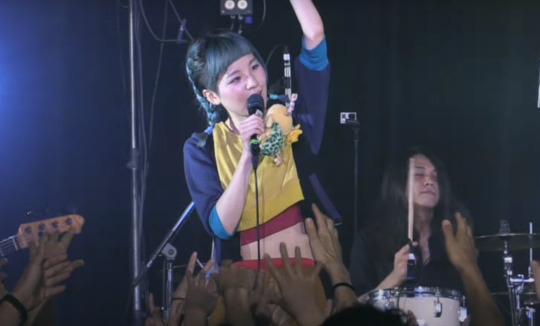
Hachigatsu’s personality fits a little more in line with a traditional idol while still not really trying to be one. She often attaches a stuffed sea turtle (who she calls Sea Tarou) to her microphone, does silly little improvised and occasionally choreographed dances and arm motions, generally more of a lovable goofball than a full-fledged idol. Hachigatsu’s unique hair style splits her hairline down the back of her head completely into two braids that hang way off the sides of her head in a way that could almost defy gravity.

Kanamil on the other hand embodies the spirit of punk rock through-and-through. In a lot of early live videos of the duo lineup, she can be seen gripping a beer rather than a stuffed sea turtle. She does her makeup and her hair up in something more a modern gyaru style, something that’s also present in her fashion, speech patterns, and usage of slang. Her hair is usually put up in an ultra-high ponytail draping over the top and hanging down over sides of her head. I only mention their hairstyles not as mundane details, but specifically because their appearances were also entirely unique and downright iconic. I have friends who have done their hair like Kanamil on the regular, much like a few years ago when people started dying the tips of their hair red like Seiko Oomori. It’s more than just a look, it’s their influence.
On paper, the dynamic between these two shouldn’t work, but on-stage, they’re unlike anyone else. They work together like apple and cinnamon. Their energies rebound off of each other. The average OYSM concert would find Hachigatsu doing silly improvised dances on stage while Kanamil would often be drunkenly stumbling around stage or jumping out into the crowd, using shoulders, hands, and faces of audience members as her stage, spitting water and beer into the crowd and creating pure chaos, something that the audience reciprocated, often culminating in non-stop movement, shoving, mosh-pits, jumping, the works. If you were wondering where BiS’ original punk fans went, you’d be hard pressed to look at an Oyasumi Hologram concert and argue that that’s not where they all went to after BiS’ disbandment. They had become the furthest thing from idol.
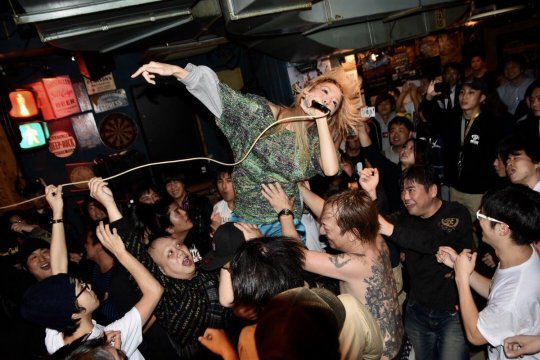
There was no more choreography, no synchronized movements, and certainly no pandering to that audience. Oyasumi Hologram had essentially become a band with two lead singers, and the dynamic between each was inexplicably just pure magic, a match made in heaven.
Ogawa took it upon himself to form a lineup on instrumentalists to serve as the group’s main backing band, consisting of Ogawa himself and Kazuma Hashiga on guitars, Taku Fukuyama on saxophone, Piro Itagaki on drums, and Junet Kobayashi on bass, also known as JitteryJackal, an alias under which he has since produced numerous remixes for the group. Eventually, Ogawa expanded his connections into several different backing bands, some taking even larger lineups featuring violin by Jun Momose, and another lineup that featured Ahito Inazawa, the famed drummer from the legendary punk rock band Number Girl.
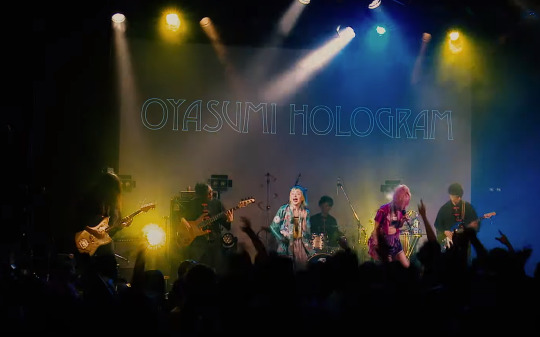
A year after this final lineup change and the formation of a backing band, Oyasumi Hologram released their debut self-titled album, an album that to this day I hold as one of my favorite Japanese releases of both the 2010s and of all time. This album is also special to IDOL iS NOT DEAD in that it’s among those albums I wrote a review for but somehow the draft went missing, and was thus never posted. If I remember correctly, something similar happened with the TOKYO BLACK HOLE and All Is Vanity reviews, though I went on to rewrite the former entirely. (Edit: While I was looking for a hyperlink to the rewritten TOKYO BLACK HOLE review, it...seems to have disappeared? I can’t find it in my archive, but here’s an ask someone sent that confirms that it certainly did exist at some point lmao)

That aside, OYSM’s debut album is unlike anything else I’ve heard since. It starts on the strongest note possible, a song called Plan that introduces them perfectly. It’s raw, abrasive, the production is dodgy, there’s feedback and grating guitar tones, and the singing is the furthest thing from what the rest of the idol scene would call clean or acceptable in terms of the tones of their voices. But all of that put together creates an absolutely beautiful mess, and that sound continues throughout most of the album with a few exceptions that show a glimpse into the sound of their sophomore LP known simply as “2″. Oyasumi Hologram’s debut album is a true 10/10.
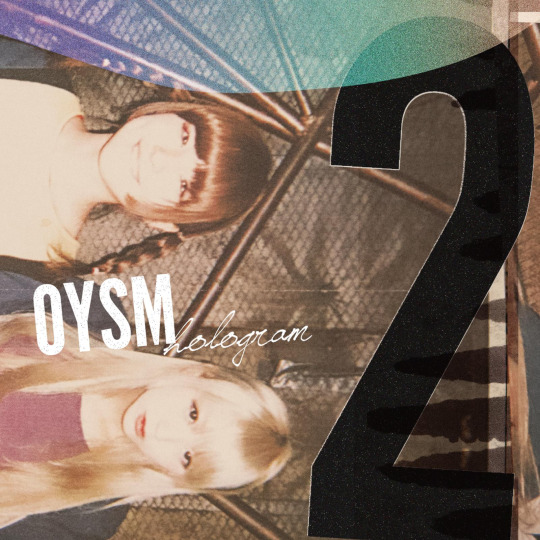
Prior to “2″′s release in early 2016 they debuted a song called Strawberry which carried the same raw punk rock sound of their first album. However, upon release, “2″ saw OYSM mostly depart their raw punk rock sound and move towards a more indie-electronic influenced sound hinted at on songs like Note and Tab Song off of their self-titled record. Guitar work was still present, although it took a cleaner tone and more of a backseat to digital production and electronic sounds on about half of the songs. Their identity however was still completely untouched, they still had this same emotional power and raw unhinged energy, and this can be seen no more clearly than on possibly their biggest song, Neuromancer.

A few months later towards the end of 2016, they went fully electronic with their third album, known simply as “...” and pronounced ‘three’. Once again, despite the almost completely digital sound of this album, they took their emotional lyricism and vocal delivery to new heights with more on-key vocals and overall cleaner production without sounding sterile or like they lost their energy. These two albums were certainly a jarring 1-2 punch after their punk rock debut, but they never the less carried their identity close and delivered some of their best songs to date, like the opener Fairytale and the closer Empty Page.
Oyasumi Hologram was carving a path of their own at this point, already having sold out their one-man tours (in Japanese music, “one-man” refers to a concert played without any opening support bands, it’s just the headliner and that’s it) in larger venues than the Shinjuku basement bars they started out playing at in between the release of “2″ and “...”.

In November 2017, they released the “15″ and “17″ EPs. The “15″ EP featured two new songs, Sorekara and Ghosting, which brought back the chaotic punk rock sounds of their debut album, while the “17″ EP featured a slow indie rock song, Slow Dancer, more akin to the sound of their second album, and three other new songs with an electronic sound like their third album. The “15″ EP in particular stands as one of the highest moments in OYSM’s discography.

These EPs lead into the release of their fourth album, aptly titled “4″ in May 2018. The opener, Colors, immediately takes the sound back to the “2″ album’s indie rock opener Kaerimichi, with a bit more energy and pop sensibility. This is still Oyasumi Hologram, but more polished than ever. The vocal delivery on “4″ was stronger and the musical sound of the album took everything they had done up to that point and put it all into one consistent 10 song album.

That November, OYSM departed to America for their first US tour, which also brought the release of a US tour-exclusive EP, “27″, which was only available as a physical CD at first (it’s on streaming now, however) and featured a new version of Neuromancer as well as a handful of songs from what would be their fifth album released in 2019, but more on that album later.
Both coastal legs of this tour was supported by black metal/dark wave alt-idol darlings Necronomidol (who readers of this blog should be very familiar with, shoutout to their producer Ricky for always plugging it in and letting us be among the international earliest promoters of their music). The west coast leg of the tour was supported by chiptune pop legend TORIENA, and the east coast leg was to be supported by my friends from the Brooklyn alt-pop duo LOVE SPREAD (Rest In Peace Ryota, I miss you), who OYSM had just released a collaborative single with in April of that year.
I was fairly broke at this time, I was interviewing for jobs during the weekend of the east coast leg and couldn’t make it out to every show like I had intended to. Had I had the money, I’d have gone to both New York shows, one of which was acoustic, and the other of which was the only show of the tour where they were playing songs from the first album. I deeply deeply regret not going to that one.
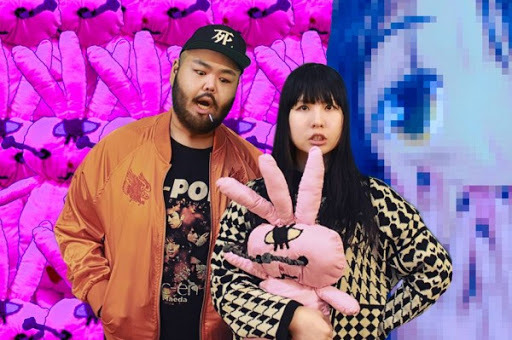
I ended up going with a friend to the Philadelphia show, which we managed to get a parallel parking spot right in front of, completely unaware that it was the venue because the outside looked like some kind of store for mausoleums and gravestones. This preceded an unbelievably weird night of sets backdropped by projections of Eraserhead and The Holy Mountain (each movie played while Oyasumi Hologram and Necroma played their sets, respectively), films which if you aren’t aware of them, provide unbelievable amounts of discomfort and anxiety, and frankly could have been a bit distracting at points.
It was also a bit off-putting that OYSM decided to play mostly songs from that new EP they were selling out the merch table that nobody had heard yet, as opposed to songs that the handful of fans there definitely knew, with the crowd reacting the most to songs like Neuromancer and Strawberry.
You could tell that most of the audience were mostly very “want to be Japanese” wotas, as the majority of people were far more receptive to Necronomidol’s set. A big thing you hear a lot of foreign artists who tour in Japan say is that the audiences are so quiet between songs you could hear a pin drop; it’s a stark contrast to American concerts where if the band doesn’t do or say anything for more than 10 seconds, the crowd will start to chatter. It was like a Japanese concert in there.
You could tell that a lot of the audience wanted to strike some kind of weird “we’re fans of Japanese music so let’s act Japanese” balance. Dead quiet between songs, very respectful of the space. And it’s because of that that I find it incredibly weird to say that more fun would be had at a Japanese Oyasumi Hologram concert, and it’s because of that “quiet enough to hear a pin drop” sentiment that makes that a weird thing. Oyasumi Hologram concerts are loud and passionate and borderline violent. This was order, not chaos. It was a strange night, but it was nevertheless an exciting and fun night, albeit a slightly morbid one.
The venue was a small art gallery just a few blocks from the river, and had no more than 50 members of the audience at best. I was excited to meet up with my friend Ryota from Love Spread at the show, who I had just talked to a few days prior to let him know I was coming through to the show. But I found out after arriving that they would no longer be playing that night, and neither Ryota nor his bandmate Narumi were anywhere to be found.
A few short days after the concert, I found out that Ryota had passed away that week. Narumi had to clarify that this wasn’t a joke, as something so grim being passed off as a joke or promotional thing wouldn’t be off-brand for Love Spread; their lyrics frequently touched on topics of death and mortality, and the video for their anthem Sayonara Forever featured images of them in funeral attire and jumping off of a roof together. Rest In Peace, Ryota. You’re missed every day and I wish I could have seen you again that night.

After their US tour, OYSM returned to Japan. On April 1st, 2019, they played a prank by rerecording Plan, only this time, it was recorded like a heavy metal song and they jested that they would become a metal band, a pretty well-executed joke that I genuinely wouldn’t have hated were it not a prank. However, it was, and in May they released their fifth and possibly final album, “5″, which featured Russell Lissack of Bloc Party fame on a handful of tracks, and returned back to their electronic-influenced sound.
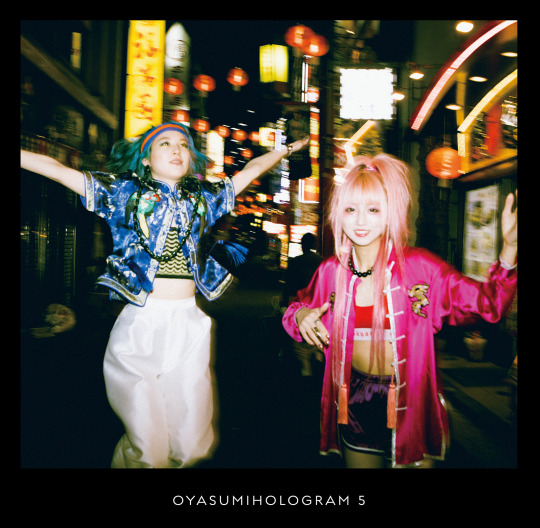
This is admittedly my least favorite Oyasumi Hologram album, but it’s by no means bad. Its release just felt a little empty due to the rerecorded version of Friday from the “3″ album for some reason appearing on it, and many of the same recordings of the same songs appearing on the “27″ EP the year prior, though that impression is very biased as there were likely less than 100 copies of that EP sold and I was one of the rare few to get my hands on it. Regardless, songs like Ghost Rider and Fire stand out as some of the best songs of the band’s electronic discography.
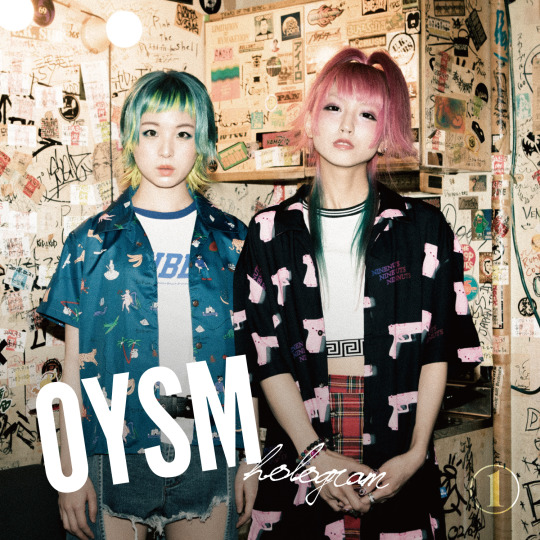
At the end of 2019, things started to look up again however, as OYSM released a compilation/best-of album titled “1″. The album cover was a recreation of the cover of their debut album’s cover, and featured them standing in the same positions in the same room. The beautiful thing about “1″ is that it features songs from throughout the beginning all the way up to the “4″ album rerecorded in the raw punk rock style of their first album, though this time, with much cleaner but still not sterile production. It’s incredible, and if this is the way we send Oyasumi Hologram off, then it’s a bittersweet ending.
Today on Halloween 2020, Hachigatsu will be officially leaving the band, as it was announced two days ago on the 29th. No fanfare, no farewell concert. Just...gone. I’m left feeling pretty hollow and confused, as I’m sure most fans of OYSM are. This feels like the very last candle being blown out. Oyasumi Hologram never made it “big” and they likely won’t be remembered as “legends” because of that, but to those who did know about one of Japan’s best kept secrets, they’ll always be legends. They always brought nonstop energy to their performances, they made absolutely every show count and never skipped a beat.

The future of the band is unclear at this point. What we do know is that Ogawa and Kanamil have talked and they want to continue in some fashion. It’s within my own personal opinion that I think they should continue with just Kanamil and focus on being a full-on band, with Kana taking on the role of a traditional frontman. Replacing Hachi just wouldn’t feel right. I know that OYSM started as an idol group, but that phase was quite short-lived and they’ve since become something entirely different, and treating them as such.
So as of right now, we don’t know what’s going to happen. It seems that Hachi’s desire to depart the group was a sudden announcement to Ogawa and Kanamil as well. They’re not under any traditional idol contracts so it’s not like they were locked into any deal or that they had to stay. They did what they did for so many years because they genuinely enjoyed it. You could often find them casually hanging out and drinking with fans after their shows, something you’d never in a million years see any idol, alt-idol or otherwise, be doing.
However the band themselves have a record deal that they announced was to end this month anyway, and they announced their intention to keep their own record label “Goodnight Records” completely independent going forward.
The strangest part of this news is that it put something into perspective that I had never even thought about before: I do not have a “favorite” member or an “oshi” or whatever you dweebs call it. I’m not bummed about Hachi’s departure because Hachi was my favorite, I’m bummed about her exit specifically because I’m going to miss the exact dynamic that only Hachi and Kana together are capable of creating. They were a + and -, like magnetism, it just worked.
And that’s all we know. I’ll likely be back soon with another post about IDOL iS NOT DEAD’s 5th anniversary and to update the Oyasumi Hologram situation, as they’re the only thing that’s left me giving half a shit about this scene over these past few years.
In the meantime, you can read the official post on Oyasumi Hologram’s website (Google translated has come a long way and will get the general point across to you English-speakers) here, you can stream Oyasumi Hologram’s music on Spotify here and you can also read our good friends at Homicidols writeup about this news here as well.
Stay safe, it’s been a scary year.
With love,
IDOL iS NOT DEAD
Post-Script:
Hey everyone. It’s been a while, hasn’t it? Do people even still use this website after the female-presenting nipple fiasco? Ah well, I need to write this somewhere and this is the best place to do it. I think the last post I made here was my ranking of The Pillows’ discography (which I’ve since updated to include Rebroadcast). A huge undertaking, but I think this post might be a bit more of one, and certainly weighs heavier than something as light-hearted as a ranking of albums.
By now it’s just a little past the 5 year anniversary of IDOL iS NOT DEAD. I’ll likely make another belated post about that particular occasion and go into some details about why I started this project (it’s actually pretty heavy, so I don’t want to add anymore weight to this already heavy post).
#punk#punk rock#japanese music#japanese punk#japanese rock#japanese idol#japanese idol music#idol music#oyasumi hologram#idol is not dead#idol is dead after this
16 notes
·
View notes
Text
Every ‘The Pillows’ Album Ranked
Alternatively Titled: “I Listened to Every Album by The Pillows so You Will Never Ever Have to Listen to OOPARTS or Smile in Your Life”
Pre-Script: This blog is not coming back. I just have not seen anyone anywhere do this yet and don’t have any better place to write this out. Also happy three year birthday to this blog. I believe the first post was September 22nd?
Edit #1: Hey babes, I’ve since come back almost two years later (dated March 10th, 2020) to make a few adjustments to the list as well as add in their 22nd album Rebroadcast, which I originally wrote this list in anticipation for.
So what’s happened while I was gone? WACK is (actually) shit, OYSM are going on a US tour with Necronomidol, anti-idol became a marketable fashion trend rather than an anti-corporate ideology, Perfume have a new most-hated album, Seiko Oomori finally flopped but ZOC looks pretty sick, Haru Nemuri rules and I’m secretly the one who tipped Fantano off to her, The Pillows are still the greatest rock band to ever live, Galileo Galilei are technically back, my name is Stanley LOONA, Astroworld is album of the year, YESEO’s DAMN RULES is a close second, Vince Staples is the greatest rapper alive and said more with one song last year than Kendrick did with his whole album, Brockhampton didn’t really exist when I last posted here, Wednesday Campanella are doing what Nakata wishes he was...what else? NieR:Automata became the greatest video game of all time and Utada’s newest album isn’t quite as bad as we all thought it would be.
Anyways, with The Pillows 22nd album dropping this week and having just wrapped up their first US tour in almost half a decade, I’ve noticed nobody has ever ranked their albums properly like all those white people music websites always rank the same Beatles albums or whatever shit. S’not fair, man. It’s an underexaggeration to say that there are a lot of Pillows albums, because there are a lot of albums by The Pillows which makes them a terrifying band to get into for an outsider (especially one who hasn’t heard of them via FLCL like so many have), and not a lot of people have listened to every single one to definitively and properly rank them. I, however, have listened to every single album by The Pillows, and I’ve listened to them a lot. And there’s a few of them that are really...really not good. So let’s talk About A Rock ‘n’ Roll Band, shall we?
1. Happy Bivouac (1999)

When you talk to a Pillows fan about the best album, if they don’t talk about the FLCL soundtrack, this and Little Busters are the ones they likely will talk about. Compared to the unique twists of many of their other albums, this one isn’t anything super out of the blue. It’s just definitively, without a doubt, the unadulterated Pillows sound. Rock bands should have stopped trying after Last Dinosaur, it just doesn’t get better than that.
This one is honestly interchangeable with the next two and maybe even Runners High, but overall, when I think of The Pillows, I think about Last Dinosaur, and I think about Beautiful Morning With You, and I think about Crazy Sunshine. Listen to this on a beautiful sunny day and just feel good while you do it. That’s the kind of band these guys are. It’s a perfect ride, on a perfect day. The whole album is the standout track.
10/10, this is it, right here.
2. Good Dreams (2004)
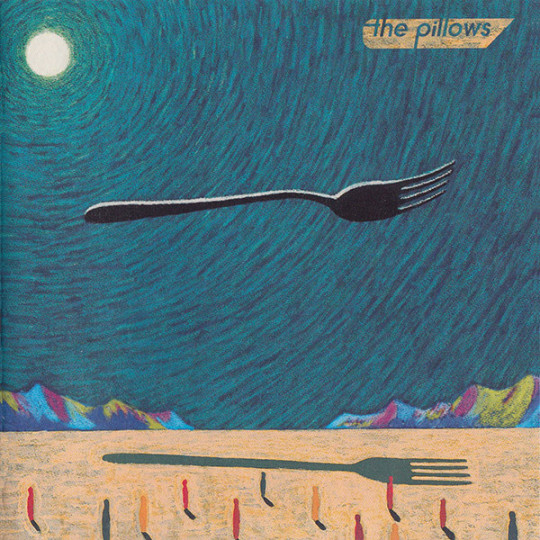
I may sound a little crazy with this one, but hear me out - Good Dreams is actually the best Pillows album. It also happens to be without a doubt the most underrated one. Now listen, I might be just a tiny bit biased because this is the first one I listened to in full, but there is something magic about listening to New Years Eve while watching a sunset. I’m actually tearing up a little bit just thinking about it.
Compared to a lot of other Pillows albums, there’s also a good amount of English on this album; the intense power-pop opener (the ever-important opener, the most important part of hooking you into an album) Xavier is entirely in English; most of the hooks are on the rest of this album. It’s pretty accessible for people less inclined to music not in their native tongue.
Sono Mirai wa Ima is almost a spiritual successor of sorts to Last Dinosaur, musically similar and just as intense. The penultimate two-parter of Bad Dreams into the titular Good Dreams is really something special. Again, nothing out of the blue happening hear, just fantastic, quintessential Pillows.
10/10, most underappreciated Pillows album to date and my personal favorite.
3. Little Busters (1998)
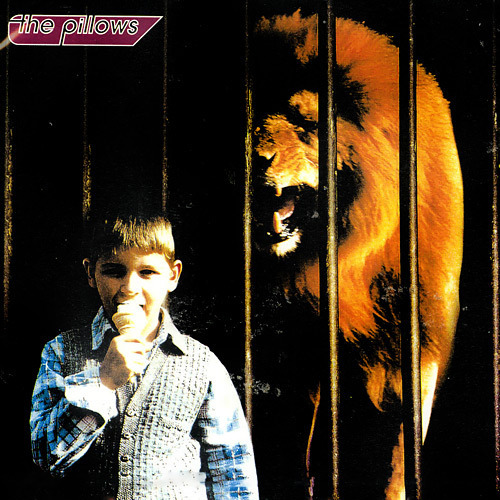
This is the other one people will tell you about. For the third time as well, there is nothing special going on here. It is just definitively perfect rock ‘n’ roll music written and performed by The Pillows. You’ll likely not hear many Good Dreams songs live, but these are some of the most essential songs in their catalogue and you’d be crazy to not listen to this one in full before going to see them in concert. Another Morning, One Life, Hybrid Rainbow, and Little Busters itself are some of their biggest and best songs to date. Just perfect, simple music.
10/10
4. My Foot (2006)
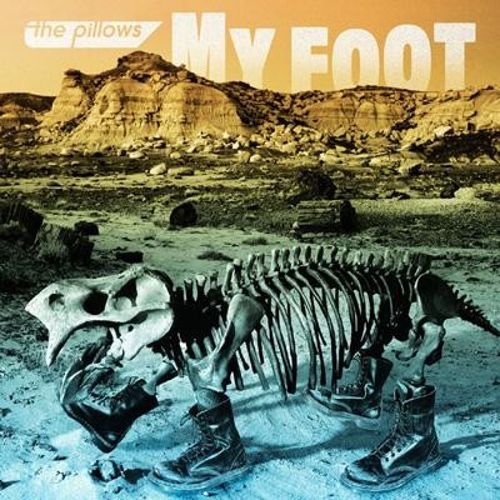
Foot fetishists be warned, this ain’t it.
I’ve been on about My Foot for years and years, and since FLCL Progressive dropped, people are finally starting to appreciate how incredible this album is. This is one of the albums where they really shook their formula up a bit, focusing a lot on the guitar work, particularly in making each guitar track - usually hard panned left and right - dance around each other and work in tandem perfectly.
Sawao said that was the main focus and difficulty in writing and recording this one, getting the guitars just right. The opener, My Foot, is an emotional high point right off the bat, and is thankfully becoming an essential part to their catalogue. The guitar balance shows right away as everything kicks in from the drums and leads into a big jangly, emotional, and pop-centric chorus. It’s not quite as legendary as the string of albums The Pillows released at the tail end of the ‘90s, but My Foot still manages to be as incredible of an album almost 10 years after the gold standard The Pillows are held to.
10/10, this is it, chief.
5. Thank You, My Twilight (2002)

IS LIFE DELICIOUS? Probably. This album sure is. The last of their albums that are finally getting the recent attention they deserve, Thank You, My Twilight (let’s just call it Twilight from here on) does very little to change up the formula they found in the late ‘90s being their second album since Happy Bivouac, but that was a godsend, as the follow-up to Happy Bivouac, Smile, was only so-so and really lacked the hooky goodness that made The Pillows special. Taking a bit of everything, including a bit of the heaviness and the close-to-your-face vocal mixing from Runners High, Twilight really does a lot in its 41 minutes, but oh boy is it worth it by the end.
The song for which the album is named has always been one of my favorite songs by The Pillows ever, period. It’s emotional chord progression, use of a cute sine synthesizer for its main melody, and blend of English and Japanese in its lyrics, Thank You, My Twilight is a perfect love song with a gigantic guitar solo and explosive ending. That simple change of the first chord during the second to last repeat of the progression at the end is one of the most simple yet emotionally wrenching examples of songwriting in rock music.
9/10
Bonus Album: Another Morning, Another Pillows

While it isn’t technically a studio album, Another Morning, Another Pillows was a double-disc B-side collection released on the same day as Thank You, My Twilight and features some of my personal favorite and most underrated Pillows songs of all time. It even features artwork that serves as a compliment to Thank You, My Twilight’s artwork, with the camera panned over to the right, featuring the band dressed in drag at the next table over.
It’s not the most cohesive album, as is its nature as a B-sides compilation, but it’s an essential for any Pillows fan and still certainly more worth listening to than a lot of the albums towards the bottom of this list.
She Is Perfect has held up to this day as one of my top 5 favorite Pillows songs, and the chorus plays in my head basically any time I look at any woman. I’ll collect my simp bucks and head for the door.
idk, maybe like 5/10. She Is Perfect is a 10/10 song tho
6. Runners High (1999)

While this is one of the most Pillows-sounding Pillows albums there is, it’s also significantly heavier and darker than anything they did before or after it. The second in their three for three run of “essential” albums (Little Busters preceded it and Happy Bivouac succeeded it), Runners High also had music like the opener Sad Sad Kiddie, Bran-new Lovesong [sic], and Instant Music featured in the original FLCL soundtrack.
On top of those, White Ash sees them getting to some of their most aggressive playing even still to date, and Wake Up, Frenzy stands as one of their most underrated songs even from one of their more overrated (read: popular, still fantastic) albums.
10/10, depending on who you ask. Just don’t ask me, cause I think more around a strong 8 to a light 9/10.
7. Moondust (2014)

I guess Stroll And Roll wasn’t a huge surprise when Moondust managed to actually capture a lot of the vulnerable feelings that The Pillows’ late ‘90s albums had. I almost feel like I should put this one a little higher? Okay yeah, let me go back. This was originally #13. This one is actually a lot better than I remember it for. Let’s put this at #10. There we go, that’s much better.
Yeah, so what can we say about Moondust? I don’t know why this one is so underrated. Happy Birthday sounds like it could be a Little Busters B-side, it’s that good. It has a lot of those sweet, emotional, warm-heart-feelings that the trilogy of late ‘90s albums managed to convey so so so well. The only bad thing I could really mention here is Tokai no Alice, which just...doesn’t feel like it belongs. The chorus/hook is a chopped up sample of what it was recorded as and played back stuttered, as if Kanye was triggering the “LOOK AT YA!?!?”’s in Runaway live on his MPC. You know, the thing he did during the Yeezus tour where he made everyone flip with just that first piano note? You know the one.
Anyways, it’s a good song, but it doesn’t fit with the rest of the album, which really all flows like it was the fourth long-lost album that should have come out in 2000 but didn’t. About A Rock ‘n’ Roll Band, the titular Moondust, and Message are other huge standouts that just do what The Pillows hadn’t quite managed to do for a good few years leading up to this. Above all of that, though, Happy Birthday is not only the best song on this album, but one of the best Pillows songs to date.
8.9/10, oh man, should I have ranked this even higher? Maybe this one is better than Stroll And Roll... I have since edited this list and put this much much higher because it truly is one of The Pillows’ best albums to date.
8. Kool Spice (1994)

And here is where the falloff happens, just a bit - this is where people usually stop ranking the albums. And despite being an almost completely indistinguishable Pillows than the one that’s since become so cherished, this album manages to do something so unique and different than the entire rest of their discography and manages to do it damn well.
Very clearly inspired by Kanye West’s “Wyoming Sessions” for which all five albums released were only 7 songs long (I’m joking, obviously), The Pillows’ third album, Kool Spice, too, is only 7 songs long. But it works. This is not The Pillows you’ve just heard in the last seven albums I’ve talked about. This is a formative Pillows, who were running off of the then-colossal Shibuya-kei trend. It’s jazzy, it’s sparkly, it’s smooth, it’s clean. But most importantly, it’s really good, despite the band not really having their own identity yet. And being just a short half hour long, it’s a really easy listen compared to their other formative albums.
Be warned though - this at its core, is a jazz album, almost a bossa nova album, to best describe it for those who’ve never heard a Shibuya-kei song before (please do go listen to Shibuya-kei and help bring it back). Twilight Park Waltz is the real highlight here, for me. It’s so smooth and I can’t help but want to dance with someone and watch the sunset (a pretty recurring theme with these guys’ music).
9/10
9. Penalty Life (2003)

Another really underrated record in their catalogue that’s only now getting the attention it deserves, Penalty Life dropped just a few days under a year before Good Dreams dropped, and gives off a slightly biting edge to it compared to everything they had released up to this point, save for Runners High. This is still definitely The Pillows at its core, though. Freebee Honey, The Sun That Will Not Rise, and Mall Town Prisoner really stand out here, while the former two are becoming staples for them now, once again thanks to the second FLCL.
8.5/10
10. Stroll And Roll (2016)

Holy crap, dude, where did this one come from? Stroll And Roll is a slightly more straight-forward Pillows album, but this is them at their best only like two years ago as of writing this (September 2018). It’s not perfect, but this is The Pillows I grew up loving. Right off the bat, Debris hits you in the face; there is no count-in, it just explodes into the song and the booming doesn’t stop - even the chorus is a huge blast, one of their biggest hooks in years.
Following that up is the 6/8 (a lovely time signature to hear rock music in) One Flew Under The Cuckoo’s Nest, an emotional banger that surprisingly doesn’t mess up the pace immediately. If anything, it keeps us moving at a brisk one for the third song I RIOT to rush us along even faster. Don’t listen to that while driving though, you’ll get a bit paranoid. You’ll hear why, maybe you can already guess.
8.5/10, how the hell did this happen?
11. Pied Piper (2009)

Anyways, with the last three albums, we’ve been at a point where people usually stop ranking The Pillows albums. I’d say Pied Piper was a pretty big album when it came out, though. No Surrender offers a fantastic crowd singalong leading into its chorus that a lot of Pillows song don’t usually have. Nothing unique here, just really straight-forward and great Pillows music. Not as legendary as its predecessors, but there are some exceptional standouts like the aforementioned No Surrender, Across The Metropolis, and Ladybird Girl.
8/10
12. Wake Up! Wake Up! Wake Up! (2007)

Two years before Pied Piper, we got Wake Up! Wake Up! Wake Up! (I’ll just say it once from here on out). I like to think of Wake Up! as the lighter but still pretty heavy version of Runners High, but less pop-centric. Or maybe too pop-centric? It just doesn’t have the oomph you’ve come to expect from their other work, but it still manages to capture the exact feeling of what makes The Pillows such a beloved band.
The biggest standout, Scarecrow, still manages to be a cult-like fan-favorite and what I would consider a yet-still essential song in the overall Pillows discography. I actually overheared a few people shouting out for it at the NYC show I went to in July. I also am really partial to The Pleasure Song which has an ultra-infectious hook and upbeat but slightly nostalgic progression and fun hard-panned dual guitar parts that remind a lot of what they did with the guitars on My Foot. Yeah...think of this album like a smoother Runners High, though.
7.5/10
13. Rebroadcast (2018)
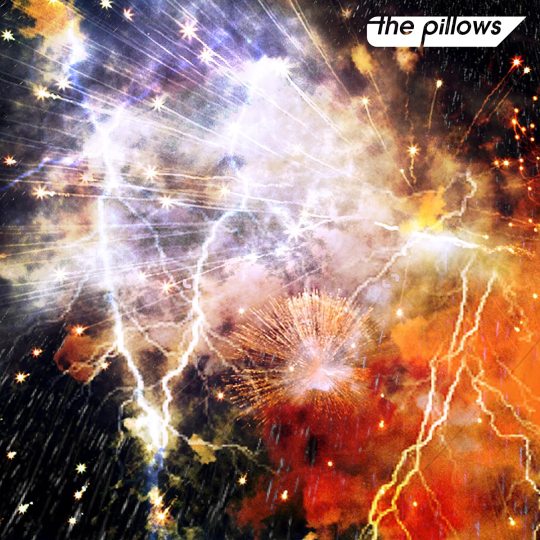
Rebroadcast was not yet out when I originally made this list, which I had actually written originally in anticipation of Rebroadcast’s September 2018 release. I’m pleased to confirm that Rebroadcast is, by all means, fantastic. The titular opening track feels absolutely triumphant and full of good energy, almost like a celebration, and it truly is - The Pillows are finally back to making consistently great records after a rough patch consisting of HORN AGAIN and OOPARTS
Rebroadcast doesn’t bring anything new or bold to the table, but it continues to deliver more of exactly what The Pillows are beloved for: really goddamn good rock music that just borders on alternative and punk songwriting. The biggest highlight here is the aforementioned namesake song Rebroadcast, as well as the second to last track BOON BOON ROCK.
7/10
14. Please Mr. Lostman (1997)

This is where The Pillows finally established their signature sound, on album #5. It’s not quite there on each and every song, but it is for most of them, and this is probably their earliest album with essential songs on it. This is where The Pillows finally made their genre transition with no hesitation. The opener, Stalker, is quite heavy, and features Sawao singing with a lot of distortion and some modulation effects on his voice. It sounds a bit like Runners High, actually, which we only had one album between here.
The second track, Trip Dancer, is The Pillows sound that we know and love, and this continues on with most of the album, save for Ice Pick and Girls Don’t Cry (clearly inspired by Frank Ocean’s hit album Boys Don’t Cry [it’s joke]), which are just a slight regressions to the sounds of their previous albums. Standouts are the albums’ namesake Please Mr. Lostman, Swanky Street, Stalker, Strange Chameleon, and Trip Dancer.
7/10, definitely my Pillows.
15. Nook In The Brain

The Pillows’ newest album, Nook In The Brain is actually pretty solid. With three more songs, it’s still the same length as Kool Spice, making it as easy of a listen. It does a lot of what Moondust and Stroll And Roll did, but a little more...I guess stiff is the word? Right off the bat we’ve got a fuzzy song called Envy. The hook isn’t huge, but it’s a solid song to start us off here and overall has some really nice chord choices that you just don’t hear in western rock music. It’s almost a little grunge-y.
Be Your King, the second track, sounds a lot like less well-produced classic Pillows. It has a hook that reminds me a lot of The Third Eye from My Foot. It’s good. Not great, but pretty good. They’ve been doing better. This album is incredibly fuzzy compare to a lot of their other records, and the hooks aren’t quite there but it’s really not bad. Nothing has been outright bad so far, but we might see some glimpses of it further down this list.
Hang A Vulture! is probably the biggest and best song on the album. It’s got a really strong, fuzzy bass and a huge hook that almost has a surf rock mode to it. Another great standout is Pulse. While it doesn’t have much in the way of a big hook going for it, the songwriting itself is phenomenal. It builds for almost the whole time into a chorus that doesn’t do too much, but the feeling of almost the whole song sounding like its the buildup to a drop is very very cool and something you don’t hear in a lot of songs. This record is actually a ways better than I remember it too, but we’ve still got a ways to go on this list, so no more time for regrets or changing the order. Other standouts that are just great songs are Jelanie and Coooming Sooon.
7/10, when it rains it pours, but when it shines it shines bright.
16. Trial (2012)

Trial was alright. It’s actually quite good; a lot better than it gets remembered for. Meaning almost not at all, despite being only a ripe six years old at the moment. It starts a little rough, the opener Revival isn’t fantastic, but it still establishes the album. The second track Rescue, however, is fantastic. It takes the dreamy major seventh chord work that Revival had worked a little more dissonantly with, and put it with the classic Pillows sound.
I’ve been saying that a lot; “classic Pillows sound”, I mean. It’s kind of a thing though. The Pillows truly have their own sound unique of any other band, despite having such incredibly heavy influences that shine very clearly in some songs more than others (you wouldn’t be wrong to think Little Busters’ One Life sounds a bit like Oasis, but Sally can wait for right now, because we’re talking about Trial here). This album actually sounds a bit like their older work in just a slight way. It takes a bit of the bouncier, more Shibuya-kei influence into its songwriting. It’s not super obvious, but you can really hear it in the Rescue chorus and songs like Flashback story.
Trial really doesn’t get the recognition it deserves as an album, because it’s still really good. Standouts are Rescue, Comic Sonic, Trial, and Ready Steady Go!.
6/10, this deserves more credit.
17. Living Field (1995)
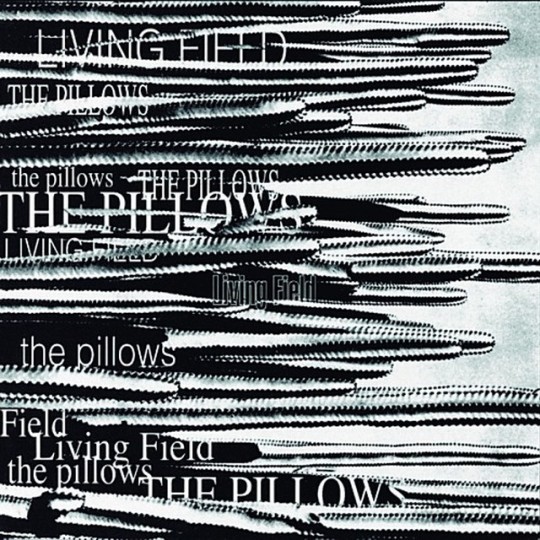
Maybe this one should be higher, because it’s certainly an easier listen than Smile, which I originally rated higher than this, but upon relistening to this while writing it, I reordered them (and again, and again, and again, and almost two years later, I edited it once again). It’s actually pretty smooth right off the bat. It’s like Kool Spice but a bit harder, a bit more focused on what they would become. This is also where they slowly start to establish their signature sound. You know the one I’m talking about, baby. That “classic Pillows sound” I’ve been going on and on about. It’s not quite here yet, but it’s slowly being established before Please Mr. Lostman really shows it to us.
It’s pretty nice actually, it’s just a bit long, sitting at a plump 43 minutes. The opener Angel Fish starts off with a really groovy drum beat, a sparkly lead, and some very interesting chords that The Pillows wouldn’t again work much with. It would be interesting to hear them reintegrate these kinds of chords into their current trademark sound. We’ve got a lot of slow jams here, but The Killing Field picks up and shows us just a tiny bit that they’re ready to come out of their shell. Not quite in the way that I Want To Be Sullivan did, but it definitely shows that they wanted to be a bit harder. This album reminds me of something that I can’t quite put my finger on, but I almost want to say the original Sonic Adventure soundtrack. Maybe something in the chord movements or the modes and accidental notes in there. I can’t quite put my finger on it. Anyways:
5.5/10
18. White Incarnation (1992)

We’re in some obscure territory now - this one’s so old I can’t even find higher quality artwork than this. Their second album, White Incarnation does everything wrong that Kool Spice does right, but still manages to do better than their debut album where they really just had no clue what they wanted to be yet. They still don’t have a clue here. It’s pretty jazzy, inspired by the Shibuya-kei movement still, but doesn’t quite pull it off like Kool Spice does.
Surprisingly, I Want To Be Sullivan shows off the potential for the band that they would eventually become and is actually one of my favorite songs by the band. They rerecorded it for an anniversary album in 2009 and started playing it live again shortly, and it really fits in with their newer material. It’s actually quite aggressive, despite the soft mixing and recording quality. But despite this, this 48 minute album is just a bit too long for how variable the enjoyment of each song is. Not too many other standout songs here.
6/10, spoiler alert: they do what this album wanted to do but better on the album that would follow it.
19. Smile (2001)

I have moved Smile down and down all the way to the very bottom now (it was originally second to last but I’ve come back almost two years after writing). We started at 17 with it. I remember it being okay. But man, this one just isn’t good. It’s not bad, but it’s not good.
I had originally put Smile all the way at the very bottom of this list, which was a bit harsh, and it has since made it’s way back up here to 19. I don’t quite know what had gotten into me writing this back in 2018, but coming back two years later to this list I think it’s unfair, because there are a few songs on here that are among my favorite and most essential Pillows songs, even if the back end of this album really starts to slog, and therein lies the problem.
There are hardly any noteworthy hooks here which kind of make or break a song, and it’s 12 song tracklist is really just a bit too long and bogs it down for how little substance each track actually has. I’ve never seen anyone say it, but maybe this one has some sentimental value for some people since it was the first album to come out since FLCL, and I’m sorry if you really like this one.
But it’s just...wew fellas, there is little to speak of here. At times, the album feels almost unfinished, with songs like Winning Come Back serving more like an interlude that they didn’t bother writing more of to be a full song, and Thunder Whales Picnic being another interlude (this time an almost 3 minute long instrumental that sounds like they mixed it down while the vocal track was muted and just said “eh” and left it as-is) that just feels out of place.
All The Way To The Edge Of This World is another solid cut with a pretty classic Pillows sound to it, but its chorus is pretty weak and the chords don’t work super well together during it, while the verse’s chords are so unbearably generic; the solo is cool tho. They wrote a better version of this song called One Flew Under The Cuckoos Nest off of 2016′s Stroll And Roll. You just read about it a little while ago. The namesake song Smile is pretty progressive sounding, but overall just slogs for six. fucking. minutes. in relative dissonance and minor chord downers.
However, that doesn’t mean it’s without it’s strong moments. I’ve retrospectively come to think about how much I like a few songs on this album. In particular, Good Morning Good News is one of my favorite Pillows songs and could fit into any of the three albums that preceded Smile with ease. Vain Dog is also just too weird of a song to not love.
Waiting At The Bus Stop is also great, it’s got a good flow, a cruising bassline, and a pretty solid hook, one of the few on the album.
3/10, and that’s being nice.
4/10, with such a strong opening string of songs, Smile quickly begins to become a bit of a snorefest.
20. Horn Again (2011)

Much like OOPARTS, Horn Again is “classic Pillows” sounding, but kind of lacks. Horn Again isn’t that bad. I think of all of their “trademark sound” albums though, it's just not as meaty as them, and at that point where you listen to a lot of that sound, it makes the older albums a lot more interesting and changes up the pace, so they’re mostly above this. But this is by no means a bad album. Mmmmmm...mostly. It’ll definitely get your head bopping, but Horn Again certainly lacks big enough hooks to really, y’know, hook you in.
It also feels like a bit more of a decaf version of Nook In The Brain. A bit loose and fuzzy with a bit more riffing guitar work. It almost feels like Sawao was starting to get afraid of big hooks. Sad Fad Love, a fully English song, shows that he’s not entirely hesitant to write big hooks, it’s got exactly what you’d expect from a Pillows hook with a big long, shouted note to start the chorus, but doesn’t quite deliver by the end of it, or maybe in the production of it with not enough background vocals to cover the longer notes in the vocal melody. There is, however, not a single essential song to their discography on this album. Brilliant Crown and Nobody Knows What Blooms also reach about the same height, but with a little more emotional brevity and the latter having this kind of cute horn section that does the opposite of what horns usually do in rock music, which is quite cool. The former is definitely the best song here, but nothing essential, once again.
4/10 tho
21. Moon Gold (1991)
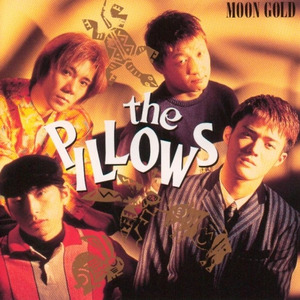
Yo, who the hell is this? This can’t be The Pillows, can it? At the very least, the following Pillows albums would at least have a defining sound that would eventually slowly morph into their signature sound, but Moon Gold almost feels like the sound that became that other sound. It’s a band trying to figure out what they are, and at this point, I think they were trying to figure out how to be a Shibuya-kei band.
4/10, this is the kind of debut for an amazing band with an amazing legacy that shows that it wasn’t always like that. I mean, not like Supercar anyway. Now that’s a debut album. I’d go as far as to say that Supercar’s Three Out Change!! is the best J-rock debut of all time.
22. OOPARTS (2009)

It’s not Oh-Parts or Oooo-parts. I believe it is OOP (as in OOPS when you mess up) and Arts. Oop Arts. Much like the Horn Again album that would follow, OOPARTS is definitely a Pillows album, but not quite to the level that albums that pioneered and solidified its sound are. The opener Dance With God even uses the same first half of the Crazy Sunshine hook, but just doesn’t do anything with it that Crazy Sunshine didn’t do better; it just feels like a cheap imitation of what they were once (and have since OOPARTS, once again become) great at. I think Lemon Drops is the biggest standout here. Not essential to their catalogue, quite a simple song, but definitely a pretty solid one that really pulls the album together nicely from both ends. It’s an otherwise overall forgettable album though.
At a mere 3/10, OOPARTS just has nothing that holds up to its older brothers.
#The Pillows#J-Rock#J Rock#Jrock#Japanese Rock#Japanese Music#Rock Music#Rock#punk rock#punk#Japanese punk#Shibuya-kei#Shibuyakei#Shibuya kei#Jazz#Jazz Rock#Pillows#Sawao Yamanaka#Yoshiaki Manabe#Shinichirou Sato#Ranked#Music List#Best Albums#Ranked List#Albums Rankings#Albums Ranked#Good Music
18 notes
·
View notes
Text
Re: The Fate of This Blog
This’ll be a bit more of a personal post. Nothing to do with anything we normally write about. But hey, Seiko Oomori’s MUTEKI just dropped, so go check that out.
So it’s been a hot minute. More than it’s probably ever been before in our absences. It’s just me here now. I don’t even remember if anyone else who’s been a part of Idol Is Not Dead was still involved the last time this blog made a post, but regardless, it’s just me now, ever hesitant to give any way of contacting me.
Some dork tried trolling us a few months ago, and it honestly made me realize that this whole project kind of had been falling apart for a bit at that point, so I decided to end it there. The Facebook page is gone, the Twitter account is gone (nice job trying to create a fake resurrected one though, double dorks.) and neither will likely be back under the same name.
I had come to a realization that I’m growing a bit out of the idol scene. There are still a good chunk of groups that I really do care about that haven’t broken up or ruined their own careers yet (though it’s looking close for CY8ER; that new version of Doki Doki Parirarura is fucking atrocious), but I overall feel very saturated by what’s out there right now.
When I started Idol Is Not Dead, Homicidols didn’t exist; Idol Is Shit didn’t exist; Straight From Japan didn’t exist; the Alt-Idol Podcast didn’t exist; Tokyo Girls Update existed, and so did Pure Idol Heart. But neither covered the subject matter that we did too much at the time. I’m not saying we were first, because that would be outright petty and hard to actually figure out. But we were certainly one of the first - if you Google either of Seiko Oomori’s first two albums, what comes up first? It’s us.
I started this because the scene was still new, and fans in the west were far and few, vocally speaking. There weren’t many English sources. I merely started this to spread the word, and I’m so so happy that other things like Homicidols and Idol Is Shit came along, even if we don’t always see eye to eye. Like I said, I’m kind of over-saturated with idol right now. Which brings me back to what I said before.
The scene was new when I started this. There wasn’t info in the west. The scene was still developing, and it showed a lot of promise that groups would be going off of BiS’ original ideals of being above the structures of the idol industry and managements. Unfortunately, that didn’t happen. I see a few groups doing it, but overall, there’s merely been an edgy “aesthetic” that’s been picked up by an embarrassingly high number of groups and that’s about it. Nothing real that’s going to shake up the industry like BiS did.
I think when WACK started and became more active with managing other idol groups is when I started to retreat a bit. It felt like they were doing exactly what they wanted to stand up against. And man, I still fucking love BiSH and I’d be lying if I didn’t say Re:STUPiD wasn’t a pretty goddamn good album, but it’s just not what it should have been. And I know those are just rose glasses on me, but it’s still unfortunate that there’s a huge wasted potential there that’s being slept on now.
Anyway, those are my personal feelings as to why I’ve decided to pull the plug of this project out. You don’t need to agree with them, you don’t need to try to convince me, because I’m not trying to convince you of anything either. It’s just how I feel. I’ll be starting a more broad blog soon, that isn’t really about any style of music or scene in particular. Just what I’m into lately. If anybody really wants a link, feel free to contact me somehow and ask for it.
I haven’t really done that great a job at “news” anyway. Homicidols has always done a better job than me. If you need a fix for that, check them out and check out Pure Idol Heart. They’re all lovely people and friends to me.
And to the trolls, you didn’t win. You only helped me out. So thanks for that, dorks.
Thanks for the support over the last two years. Also damn, I totally think it’s roughly around the two year anniversary of Idol Is Not Dead. I don’t remember the exact date now that the Twitter is gone, but it was definitely around the end of September, and the 26th sounds about right. So happy anniversary. Thanks again, to everyone who’s looked at us. You’re keeping idol very not dead.
3 notes
·
View notes
Note
no shade but what do you mean by "mexican christianity" on the seiko review?? christians are a minority in mexico. maybe you meant catholicism.
Apologies for not sounding politically correct, I guess. Now, I’m neither religious (anymore) nor am I Mexican, however, as far as I’m aware, Christianity is the tree that Catholicism is a branch on. Catholicism is to Christianity what spiders are to arachnids, as far as I’m aware.
Anyways, it’s just a general aesthetic I picked up based on what I learned as a kid, what I’ve seen in media (which is obviously not a great platform to garner a view like this on, so that’s totally me in the wrong here), and what I’ve learned from my friends’ families. Just give “Mexican Catholicism” a quick Google Image search, take any image that comes up on the first page, and put an opaque layer of pink over it. Then compare that picture to something like the Dogma Magma music video. Looks quite similar.
Anyways, apologies if that’s incorrect or insensitive, and please by all means, let me know (in a non-aggressive manner, mind you) if it does happen to be and I’d be glad to change it around and learn a little.
2 notes
·
View notes
Note
Great review again! I'm seriously hyped for the album now. It's so good that you keep promoting Seiko Oomori for the west. That picture of Drake's head on Seiko's body will haunt me though^^ (P.S. I enjoyed SUNNY. "Flight JL005", "Quiet Counterattack" and "Carnation" are great. "Nippon" sucks )
Thanks a lot for the support! I mean, SUNNY isn’t a bad album by any means. It’s just a bad Ringo album. That’s by all means a valid basis. It’s impossible to appreciate something as a single individual work when the artist has released five or six absolute landmarks previously, not counting any of the better Tokyo Jihen albums.
Anyways, it’s lovely seeing Seiko’s fanbase in the west grow like it’s been. When I got into her, and even still a little bit when I started doing this blog, there really wasn’t anything in English about her save for a few really small blogspot reviews and an even smaller number of tweets about her. Now there’s entire blogs dedicated to translations (http://kittysblues.tumblr.com/) and the like.
Thanks again!
1 note
·
View note
Text
Seiko Oomori - kitixxxgaia - Review
If you’ve read this blog before, you probably have a pretty good idea of my completely unbiased admiration for Seiko Oomori and everything she does. “Unbiased”.
So let’s just get to it. Less than a year, by about two weeks maybe to be precise, Seiko Oomori follows up her critically acclaimed major sophomore album (fourth overall) TOKYO BLACK HOLE with something even bigger, even more political, even more honest, and even more ambitious. I’m going to start off by changing my previous opinion. TOKYO BLACK HOLE is like an 8.5 now. Stay with me, here now and buckle up; we’re going for a ride, my friends.

The same week the United States got unleashed with the marvel of Drake’s More Life – a notably emotional return to form that also doesn’t shy away too far from the newer territory Toronto’s first celebratory hero has been invading – Japan was hit with something similarly parallel. Seiko Oomori gave us her fifth album kitixxxgaia on March 15th. Just like Drizzy, Seiko has given us an equally emotional experience, that still covers her recent sounds while almost giving us a slight return to her punk roots save for the general lack of an obvious acoustic guitar in most of the mixes (though it’s worth noting that it’s still there, just buried in the mix; I’ll get to why such a jam-packed mix actually works in a minute).
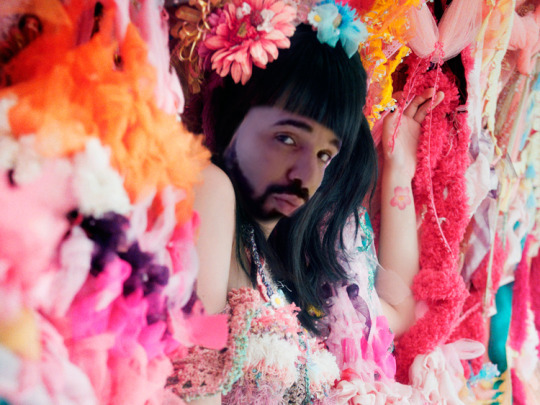
It’s amazing to see that the west and the east were both delivered promising projects by two of their biggest masters of music and emotion. It’s amazing to see just how far some shitty kid from Koenji has come in just five years since her official debut PINK in 2012. It’s amazing to think that that’s six albums if you count PINK, seven if you count the mostly self-covering Pink Tokarev album of 2015, which was otherwise an off-year for everyone’s favorite singer to imitate.
The only word I can describe how kitixxxgaia sounds with is “big”. And several other adjectives. Maybe “gigantic”. Maybe “colossal”. It’s a fucking huge album, pardon my French. This is potentially Seiko’s first Ringo Sheena-level album (let’s just forget that SUNNY happened for a minute). There’s a lot of religious imagery and a heavy aesthetic. I’d highly suggest on your first listen, you watch the music videos for every song that has one. So start with the “Dogma Magma” video, then the “Hikokuminteki Hero” video, listen to “IDOL SONG” normally, then when “Gutto Kuru Summer” comes along, watch that video too. And so on.
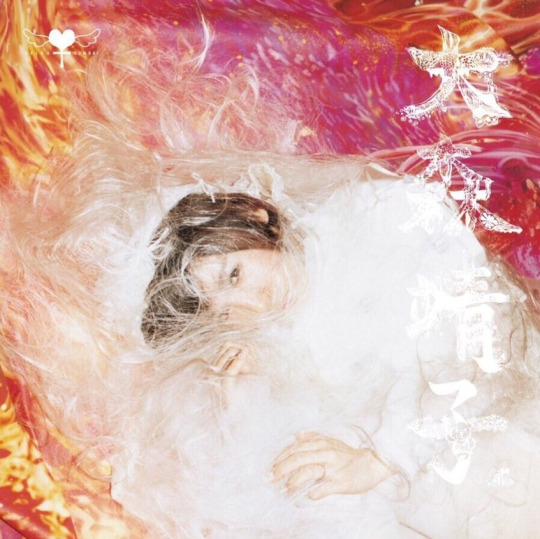
kitixxxgaia is heavy in its use of a very specific aesthetic, which takes influence from Christianity (and a hint of Mexican-style Christianity at that), weddings, quite a bit of Dadaism, and it’s all absolutely drenched in shades of pink and lighter blues. It’s the kind of album that’s best to be experienced both by listening and watching, as I said before. There are heaps of promotional images that came along with the album and the original “holy trinity” singles that lead up to its release, and I’d suggest maybe even just looking through those around Twitter and wherever else you can find them (maybe I’ll compile what I can find and make a post later this week) while you listen to the songs that aren’t accompanied by music videos. It’s the kind of multi-media work that could induce a sensory-overload in someone with synesthesia, like myself.
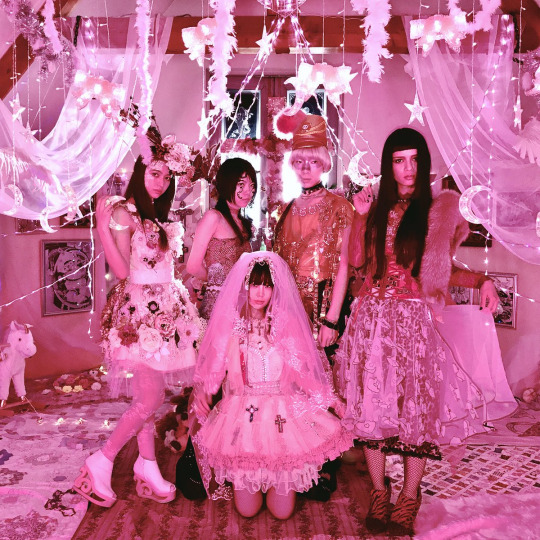
Now before I even get into the music of it, I want to point out the name of the album itself. Just the name kitixxxgaia (say it in English how you want, I generally say “Kitty Gaia”), much like her lyrics, takes some wordplay. In Japanese, the word “kichigai” - short for “[anta no] ki ga chigaimasu”, though nobody would ever say it that formally - is essentially the closest the Japanese language can get to the level of offense that words like (cover your children’s eyes) “fuck” or “cunt”. It doesn’t mean the same thing, but it’s that sort of level of offense, though deeper seeing as Japan is culturally much more introverted than we are over here.
Kichigai could loosely be translated to “you’re fucking crazy, man; you’re out of your goddamn mind.” Not in like a “woah dude that’s a fucking siiiick tattoo of a wolf” kind of way, though. It’s an insult, not a term of endearment. Adding the “a” to the end, Seiko turns it into “kichigaia” (キチガイア). After a day or two, she officially changed the name to romaji, now calling it “kitixxxgaia”, censoring it (possibly for management, cultural, and radio airplay reasons, but we don’t know specifically) by making it English and with three x’s in the middle. This name, to me, holds two simultaneous meanings, again, much like her signature style of lyricism.
The “kiti” could be interpreted as “kitschy”, a word referring to style in poor taste, much like our girl Seiko’s aesthetic. The word “gaia” is the personification of our planet Earth in ancient Greek texts. So it’s a “Kitschy World”.
“kitixxxgaia” in its original meaning, “Crazy Fucking World”.
Now to the music: Seiko has never let us down with a strong opener, and this might be the most in-your-face, unexpected opener, titled “Dogma Magma”. “Come on up to the emotional stage!” she blurts out before a gong bangs in your face; the remainder of the measure in silence before another hits with a choir on top, just underneath a piano playing downward arpeggios, and below that, some intricate string work, each instrument holding its breath. After the four bar intro, we crescendo up to the main song. Enter a not-quite shibuya-kei type beat – syncopated and staccato-like drums underneath a jittery, major piano progression. Behind it all is Seiko’s voice distorted, seemingly having a conversation with God.
As the filter cuts off, Seiko enters with some of her most provoking, forward lyrics ever written: (rough translation by yours truly): "Once upon a time there was something other than [just] male and female. Once upon a time there was something other than [just] white, black, and yellow [people]. Once upon a time there was something other than [just] yes and no. These things had always always existed, but it was then instead decided that they didn’t [exist].” she sings, touching on the recently hot topics of gender, race, and consent.
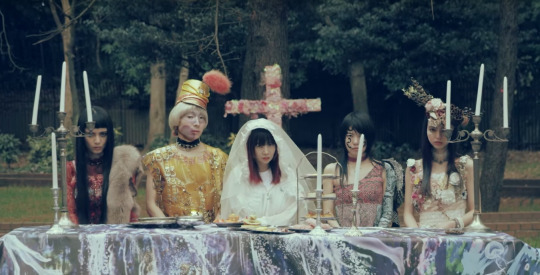
She continues “When I opened my eyes I was Japanese. I’m a goddess but I’m too uncomfortable in this inconvenient body to go outside without makeup on.”, a clear reference to body positivity clashing with self-esteem issues, and likely even cultural pressure in Japanese society. “Dogma Magma” has cuts into a more punk style chorus, reminiscent of “Magic Mirror”. “What will you do during the revolution? Just one heart? Fuck you, fuck [you] all, because this is war!” There she is. That’s the Seiko we know and love.
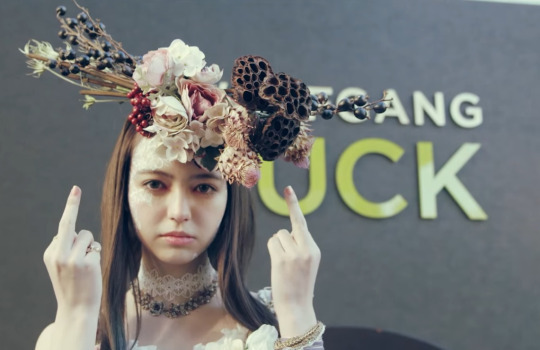
Track three is of note because it sort of takes me back to when she used to advertise herself as an idol during the Zettai Shoujo era for extra shock value. A clever parody on idol music and culture, “IDOL SONG” could almost pass off as a generic denpa song à la Band Ja Naimon!.
“JI・MO・TO no Kao Kawaii Tomodachi” (roughly “JI・MO・TO’s Cute-Faced Friend”) is certainly one of her most out-there songs, with a catchy, sugary hook, an almost rap verse not too different from what she did with “Zettai Kanojo”. It’s light, it’s bouncy, and it’s really good. This whole album is really good. Good. Good. Good. Good. It’s good music (Cruel Winter, when? I need answers, Kanye!).
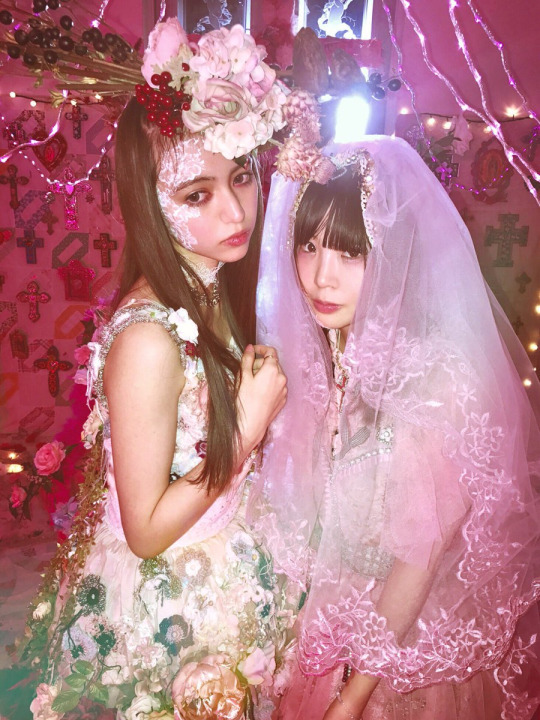
Speaking of rapping, two songs later, Seiko gives us the ultimate collab for this generation of J-pop. Much like Ringo Sheena and Utada Hikaru’s “Nijikan Dake no Vacation” (roughly “A Vacation For Just The Two Of Us”), “Chikyuu Saigo no Futari” (roughly: “The Last Two People on Earth”) opens up eerily, with a huge texture and an oozing sub bass that launches into this groovy, dark, rhythmic masterpiece. Seiko begins “Dora-chan, warmest welcome to the 21st century, where mass production has made humans more like robots. Justice is brought by violence, the death penalty is given immediately unless you’re cute.” Seiko is soon interrupted: “I’m being forced to be stupid, these frames in front of me are out of my league. Fuck you, guidance! In my head, I’m punk.” Is that voice DAOKO? You bet your ass it is, and she is spitting that truth all over this track.

God there’s so much more to cover for this album but I really don’t want to ruin too much of it by blabbing on. Up next, continuing with the album’s religious themes “Pink Methuselah” brings a familiar sound with a twist – once it kicks in, it’s very clearly Kenta Sakurai (ex. Izukoneko, current Maison Book Girl, TOKYO BLACK HOLE’s “SHINPIN” producer) behind the producer’s chair on this one, but unlike “SHINPIN” from Seiko’s previous album, it’s not just another Sakurai song. It’s very clear how much Seiko added on top of what he did, and it’s like the perfect blend of both of their signature styles.

The album also features a menacing, full-piano self-cover of °C-ute’s “Mugen Climax”, a song that Seiko wrote for the extremely popular Hello! Project group. Now, she’ll never avoid Ringo Sheena comparisons – after all, Oomori’s debut album Mahou Ga…’s artwork pays direct tribute to Sheena’s legendary 2000 album Shouso Strip’s artwork - but what hearing this self-cover (which makes °C-ute’s version almost unlistenable) makes me want is a self-cover album from Seiko once she garners enough writing credits, much like Ringo Sheena’s Utaite Myouri.
The thing here about kitixxxgaia is that the album finishes off differently depending on the version you have. There are three versions: Dogma, Karma, and Gaia. Every version comes with a second “disc” that’s a DVD/Blu Ray; Dogma comes with a live Blu Ray of ZEPP Tokyo stop of the Tokyo Black Hole Tour, Gaia comes with live audio of that same show as well as a DVD of all of the album’s music videos, and Karma comes with a live DVD of a few different shows from last year. Each version also has a key difference to the main album – the final track is different.

As my personal recommendation, Dogma is the ideal version. Karma and Gaia finish off with new songs, but Dogma closes out with an acoustic re-recording of the Zettai Shoujo single “Kimi to Eiga” (literally: “Movie With You”). Since the closest thing we get to ‘acoustic’ on kitixxxgaia is “Mugen Climax” and “Orion Za”, this is a necessity to the album’s closure and really puts into perspective just how far Seiko has come since her humble beginnings.

The Karma song is called “Ramen no Hanashi” (literally “Ramen Conversation”) and the Gaia song is called “M”. “M” is another piano song, cutting in at just over 6 minutes. “Ramen no Hanashi” also does a similar job to “Kimi to Eiga”, being a full-acoustic track, and it’s a bonus that it’s a new song as well, so if you’re looking for a fully new experience or you’re not familiar with the Zettai Shoujo classic, maybe the Karma version is more for you. Either way, it’s a really nice way to end the album with some retrospect.

IDOL iS NOT DEAD gives kitixxxgaia a perfect 10/10. 11/10. Screw it. Whatever. It’s so goddamn good, just stop reading and go listen oh my god
13 notes
·
View notes
Note
Your review of Tokyo Black Hole was great! Your writing style is easy to read and entertaining. Will you also review her new album kitixxxgaia? Keep doing the good work!
Oh, I absolutely, and I appreciate the kind words. I’m actually taking the time to dig into kitixxxgaia right now, but my early impressions have it in a better place than Tokyo Black Hole, which I’m most likely gonna have to reduce the score over.
It’ll probably be a week or two before I start even writing it, though. I just want to really soak this up first. It’s absolutely magical.
0 notes
Text
Necronomidol – DEATHLESS - Review
Less than a year since their fantastic EP from chaos born, Necronomidol returns with their sophomore album DEATHLESS, a brutal masterpiece lyrically touching into the darkest subjects idols have touched upon, taking advantage of abyssal H.P. Lovecraft-esque imagery from which they take their name from. They were also kind enough to provide me English translations for every song on the album in my press copy! Everything about this release shows that they went the extra mile here.

The record, like “from chaos born” opens up with a post-black metal banger, “END OF DAYS”. The very first note just hits you like a canon. It’s littered with lazy blast beats, tremolo’d minor chords, and chilling harmonies carefully woven into haunting melodies once the song opens up into a more uplifting refrain. I’m gonna go on a bold note and say that this is the best song in the entire Necroma (official nickname for the group, for those uninitiated) catalogue. This is the kind of song that will eagerly piss off the “kvlt” type kids, and that’s what makes this group so special. If you can get on “kvlt” black metal fans’ nerves, doesn’t that make you more metal than them if they’re bothered that much? I digress.

But speaking of “nerves”, the third track in is Necroma’s familiarly seminal “SKULLS IN THE STARS”. Some may be surprised to hear this one again, but I’m personally not. “SKULLS IN THE STARS”, in my honest opinion, is Necroma’s equivalent to BiS’ “nerve”. This time around, it features a tighter mix than before and is a much more pleasing listening experience. DEATHLESS is also the group’s first release to feature their newest members Rei Imaizumi and Himari Tsukishiro.
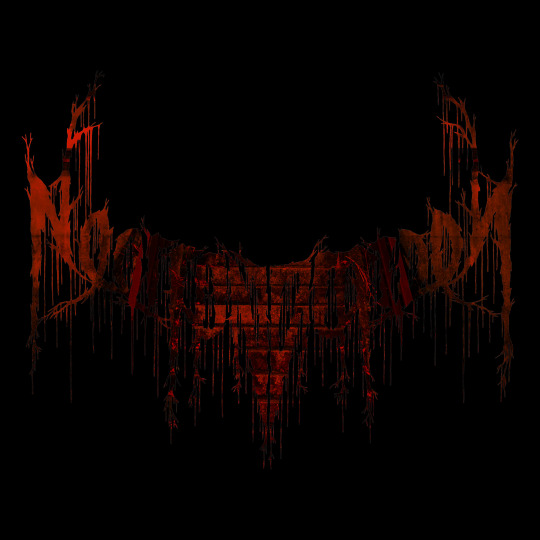
DEATHLESS also packs in a good number of those moody darkwave songs that made up most of their first record, Nemesis; Songs like “4.7L”, “CHUNGKING REDLINE”, and of course “SKULLS IN THE STARS”. The thing here is that the production quality is so much cleaner than ever before. This goes for all of the songs on the record; everything is crystal clear and an all-around good listening experience. The thing about these dark wave tracks on this record is that a lot of them take the extra mile to use a few conventional instruments: ear splitting guitars paired with side-chain compression to give the songs a pumping, heavy feel.
Everything feels in place on DEATHLESS. It’s their most well-produced record to date with a really consistent, well-paced tracklist to keep you hanging on for all 36 minutes of it. It’s a must-have for existing Necroma fans and for anyone who perhaps wasn’t quite into what they heard before, be it for the production quality or style of songwriting. If you weren’t big on their older material, you might want to give them one more try here. Necronomidol once again succeeds their previous release with something even better.

IDOL iS NOT DEAD gives DEATHLESS a 9.5/10.
2 notes
·
View notes
Note
Will you still post a review of Tokyo Black Hole or is this blog dead?
Hey! Sorry for the late response. Ughhhh I just typed out a nice long answer and then someone texted me and the app refreshed and delete it when I came back. So that should answer the question regarding inactivity of this blog.Anyways, in short, we plan on making this blog more active than ever by the end of the month. There are a handful of unreleased reviews that we'll probably roll out once a week, along with other types of weekly content, write-ups, and discussions.As for the Tokyo Black Hole review, it...well, it existed, but I'm not sure where it went. I think it got overwritten or delete or something. But I'm very intent on rewriting it with a clearer mind! I've had a lot more time to really sit down and appreciate it more and more since it released. So that may be the first review we'll post, along with the holy trinity of singles she dropped during the last half of 2016.Sorry again for the late response!
0 notes
Text
Necronomidol - from chaos born EP - Review
Pre-Script: Really late on this. We have a few reviews, starting from around the time Tokyo Black Hole dropped to now, that we haven’t posted. So we’ll be scattering them out and posting them every now and then for a bit. Trying to get this more active again, but in the mean time, you should definitely check out our friends at Homicidols, who manage to do a much better, more active job than us.
Just under four short months from the release of their debut album Nemesis, Necronomidol returns with their brand new EP from chaos born [sic]. They’ve been promoting the release by debuting one new song every week leading up to the release.
Necroma (the settled-on abbreviation for Necronomidol), for those out of the loop, were one of the first idol groups to gain notoriety around the time BABYMETAL went viral, but stuck to a far more abrasive, black metal and darkwave-inspired sound. Their older releases gave a very raw sound, typical to the old black metal standard set by groups like Darkthrone and Mayhem, which most likely turned BABYMETAL fans looking for something similar off in a lot of ways. [Side-Note to BABYMETAL Fans Looking for Something Similar: stop your search, there’s nothing similar to BABYMETAL, and anti-idol is not this “kawaii metal” thing you’re all on about. What you’re hunting for doesn’t exist. Please stop saying BABYMETAL is better than PassCode. Thanks.]
from chaos born brings a lot of new elements to the table for Necroma. For starters, there’s no darkwave on here. Like at all. So if you’re like me and you want to hear Skulls In The Stars 2, tough luck. But what Necroma does serve up here is a more multi-genre endeavor than they’ve gone on before.
The first song psychopomp is a polished black metal-inspired tune with hints of dreamy shoegaze, not too dissimilar to the kind of sound you’d expect from Deafheaven if they crossed over with Watain and, you know…idol.
Continuing with their journey into new territory, Shimin Kaihougun brings forward influences of power metal, a little reminiscent of Oceanborn-era Nightwish and a bit of Dragonforce sprinkled in. The third track Nyx almost takes a more punk influence to its sound with fun add synths dancing around the mix during the chorus.
Down the way, Midnight Dominator takes a big hint from the likes of Metallica and Celtic Frost. Easily the biggest sounding song on the album, the first note that hits is like a huge punch to the face. The song is littered with wah’d-out guitars, palm muting, harmonics, and a steady, flowing drum beat. This lays down a really nice contrast to the quieter chorus, which drops the guitars from the mix so that all that’s left is the girls, the drums, the bass, and an airy, eerie pad synth(?) in the background before kicking the door back down into more Kirk Hammett guitar solos.
The final song, Idol Elegy, will probably be really familiar sounding if you’re a fan of Bellring Girls Heart. Plucky, catchy synths, prominently bright and steady acoustic guitar with a riding bassline and lighter drums draw reminders of songs like Bokura no Wednesday and Starlight Sorrow.
Littered with catchy hooks, a huge step forward in production quality, and ventures into new genres without leaving their familiar dark vibes behind, Necronomidol returns quickly to the scene with from chaos born, their best work to date.
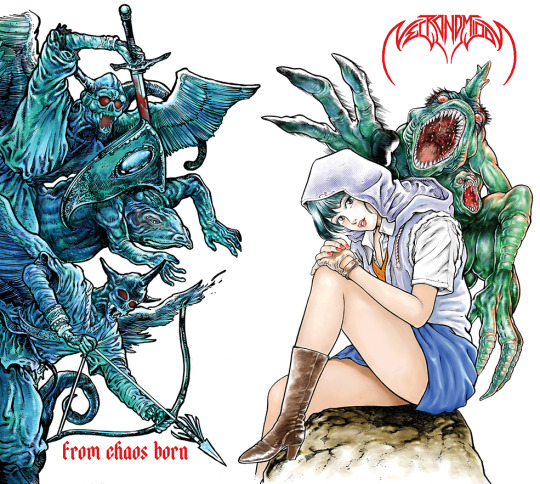
IDOL iS NOT DEAD gives from chaos born a 9/10.
3 notes
·
View notes
Text
Seiko Oomori - Seiko Oomori & The Pink Tokarev - Review
Pre-Script: TOKYO BLACK HOLE is out right now in Japan! We’ll have a review up once we’ve gone deep into it for a little bit. Expect it early next week.
Seiko Oomori’s most recent release is a collaboration album of sorts with her old backing band of several years, The Pink Tokarev, whom she broke up shortly before the release of this album in early 2015. Fittingly titled Seiko Oomori & The Pink Tokarev, the first and last album with the band features only a handful of new songs, but mostly covers from Mahou Ga… and Zettai Shoujo, though the tracklisting and arrangements breathe new life into them.
Starting the album is the “single” hayatochiri from 2013’s Zettai Shoujo [it should be worth noting that both Mahou Ga… and Zettai Shoujo … were released in 2013, in March and December respectively], this time around as a punk rendition of the fully-acoustic song from 2013. This introduces the wild, often noisy and flashy sound of The Pink Tokarev well, with Seiko’s noticeable acoustic guitar still apparent in the background. The Pink Tokarev themselves are known for their lively stage performances, often swinging their guitars all about, clad in overly-deco fashion, fabrics and flowers hanging from the guitar straps and all. This aesthetic image matches their sound almost too perfectly, but also gives Seiko a chance to get more wild as well, with her voice cracking and squeaking all over the place.
The second song, Wonderful World End, which lends its name to the 2015 feature film that she helped collaborate on, is one of the only new songs on the album. With a chord progression a little too similar to Zettai Shoujo’s Amai, the song has become a recent favorite in Oomori’s live performance, with an enthusiastic sing-along to the “no music, no music” lyric. Keeping with the Amai similarities, the song maintains an equally as emotional feeling which reaches a climax by the end with Seiko singing far too out of her range over the steady main progression and a noisy but simple guitar solo, releasing itself into a Seiko and her acoustic guitar alone singing the main post-chorus “oh-woah oh-woah oh-woah oh-woah oh” melody in a somber and shaky voice.
Next up we find Shoujo 3-gou (roughly: Girl #3), another song from Zettai Shoujo, which unlike most of the rerecorded songs on The Pink Tokarev, bares very few differences from the original song. After this we find the new [side note: I actually need confirmation on this, as I can’t find info in Japanese or English anywhere I’ve looked] song Mikan No Uta, not to be confused with the famous Sex Machineguns song. It’s a slow, chugging rock ‘n’ roll song which features a lot of screaming, coughing(?), and blues riffs. This is Seiko essentially doing metal in her own way.
After that little experience we find ourselves with the redone version of Midnight Seijun Isei Kouyuu (roughly, literally: Midnight Innocent Heterosexual Friendship) which translates very well to a punk rock song from the pop hit that she originally wrote it as. This isn’t the first time we’ve heard a redone version of this, with an almost-ska version on the Poi Dol collaboration album with Lai Lai Lai Team, but this might be the best version there is outside of any solo live version where she ends up breaking her guitar and singing without accompaniment (it’s happened a handful of times). The Pink Tokarev breathes new life into this song, replacing the noisy breakdown with a traditional guitar solo, and upping the energy to 11.
Further down the way, we find the redone version of Mahou Ga’s Shinjuku. Again, The Tokarev turns an otherwise pop song into an energetic rock song. The reason I decided to dedicate a part of the review to this song, however, is because of the infamous first line “Kyary Pamyu Pamyu’s ‘Everyone’s Song’ is a shitty song”. Due to this being a major label release on Avex, Oomori had to avoid copyright (maybe even controversy) infringement by mumbling of the “Kyary Pamyu Pamyu” part.
Other songs of notability are the redone versions of Over The Party and Saishuu Koen and the new, almost-acoustic (though played with an electric guitar) song Ichigo Frappe Wa Tokete Ita (literally: Strawberry Frappe Has Melted). The tracklisting and inclusion of a few new songs makes this a highly enjoyable album, especially if you’re already familiar with most of the old songs. It’s great hearing them in a new, energetic light.
With the announcement of the breakup, Seiko had this to say on her personal Ameblo (translation by Tokyo Girls Update):
“If there are 10,000 people, then in order to pull 10,000 people into my world, I must have 10,000 people’s worth of experiences, and in that direction that I, Seiko Oomori have dived head first, awkwardly stumbling into my work from the beginning of the new year. As if shedding my own skin, I’ve cut and dyed my hair, and on bad days, I’ve even tossed my clothes into the trash, while thinking about how I can’t wait for the band to grow. I’ve said that you should live fast while you’re young, even though I’m the youngest and nearing thirty.”
Seiko Oomori & The Pink Tokarev is probably an album for the superfan in a lot of cases, but it’s a great listen that’s worth your time if you want to find something new to listen to.
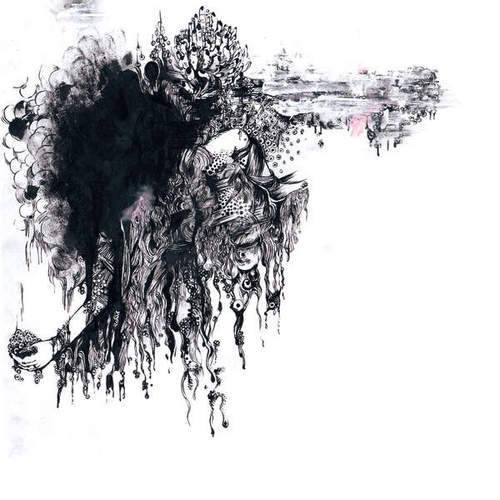
IDOL iS NOT DEAD gives Seiko Oomori & The Pink Tokarev a 9/10.
#idol#idol is not dead#idol music#anti-idol#punk#punk rock#seiko oomori#oomori seiko#music#music blog#jpop#j pop#j-pop#japanese#japan#japanese pop music#japanese pop#jrock#j rock#j-rock#japanese rock#japanese music#review#the pink tokarev#pink tokarev#tokarev
3 notes
·
View notes
Text
Seiko Oomori - Sennou - Review
Seiko Oomori’s most recent album of all new songs, Sennou (literally: Brainwashing), features her complete change to from folk-punk to straight up pop music. However, Oomori throws in a few pleasant surprises and references to previous works on her major label debut with Avex.
The album begins with a typical Seiko rambling and kicks in with a fast punk song, Zettai Zetsubou Zekkouchou (roughly: Absolute Despair, Top Condition), which transcends from being just a punk song into all sorts of wild, kind of sparkly instrumentation, including bells and chiptune and a string section. The chorus sets the tone of the album with indecisive lyrics “Absolute despair, top condition. No, I’m sorry, I don’t honestly mean that. Goodbye, I loved you so much, you’re so beautiful, but you’re disgusting; I hate you.” Don’t think Seiko has gone and sold out here. This theme of indecision carries out through each and every one of of Sennou’s weird-as-fuck 52 minutes.
The first four songs on the album are the four lead singles, the second of which, Imitation Girl, is a radio-ready dance tune which repeats the lyrics “Imitation, you are the unknown meaning of this tension; imitation girl.” There’s not too much of Seiko’s usual snarkiness here, just a good pop song that deals with not-so-pop themes. Oh, but she toooootally says “fuck and peace” in English in the verse. That’ll probably slide by a handful of casual listeners.
The next track, the single Kyurukyuru, is the high point of the album. It features a heavy power-pop style that accentuates the chorus, featuring a lot of high, almost held-back yelling from Seiko.
After Kyurukyuru, we find ourselves already at an emotional climax in Nostalgic J-Pop (side-note: I named and themed one of my mixtapes after this song). The song deals with the heavy topics of chronic depression, suicide, and the ever-spinning rumormill. “The rumors are a bit different, help me understand, help me understand, Nostalgic J-Pop!”
And this is where the albums gets a little weirder; a tad experimental, even. Nana-chan no Saisei Kouza (roughly: Nana-chan’s Playback Course) with a kind of a jittery piano shuffle. Kodomo Ja Nai Mon 17 is one of the most notable songs past the singles, which has an oddly familiar melody and a catchy chorus.
Further down the line at the end of the album, we find the full-acoustic Date Wa Yame Yo! (literally: Let’s Not Go On A Date), which describes Seiko’s ideal date of buying her ice cream at the convenience store, going back to her place, eating it, and getting your ecchi on. All of which she concludes is actually a shitty idea. The bad quality one-take acoustic recording is sure to please fans of Oomori’s older work, especially since this song has been floating around the internet since a little before Zettai Shoujo came out.
It’s got a strange pacing and shoves most of the good stuff at the beginning, but Sennou is one of Seiko’s best albums, if not for it’s strange approach to transitioning to an experimental pop sound. The lead singles are her catchiest and easiest to listen to songs, but if you already know you’re interested in Seiko Oomori, this might not be the best place to start.
IDOL iS NOT DEAD gives Sennou an 8/10.

Tomorrow we’ll review the collaboration album Seiko Oomori & The Pink Tokarev, which consists of a few new songs and covers of Zettai Shoujo and Mahou Ga... songs
1 note
·
View note
Text
Seiko Oomori - Zettai Shoujo - Review
Pre-Script: I hate having to do pre-scripts. It’s just unprofessional, but I guess we’re not really professional ourselves…anyway, apologies for this and Sennou being posted on the same evening. I had had this scheduled to post last night, but I embarrassingly scheduled it on my personal blog, and not to this one. So, apologies once again. Now, to the review.
Here we continue our daily Seiko Oomori reviews with what I’ll outright say is her best work to date, Zettai Shoujo (literally: Absolute Girl). Without my bias getting in the way, this, along with BiS’ IDOL iS DEAD, is one of the most important anti-idol records ever. There’s so much I can biasedly say about what this album means to me, but I tweet about that enough on my personal. In short, this is the essential Seiko Oomori album; all of her tricks, gimmicks, subtle intricacies, antics, ranting, screaming, crying…it’s all here.
Zettai Shoujo started an era of sorts for Oomori, where she slowly made the transition to completely passable, yet still distinctly tongue-in-cheek pop music. Along with Seiko’s approach to the track-listing on Zettai Shoujo, it’s remarkably the most punk rock album in its marketing as well; the album begins with two sugary pop tunes (which also happen to be two of the lead singles) and takes a very, very sharp downward spiral.
The album begins with Zettai Kanojo (roughly: Absolute Girl), a warm and sugary pop tune which details a strange encounter with a Mickey Mouse mascot at Disneyland, which ends up just being a dream, a girl-power chorus, and a stuttering, rushed, nervous rant of a bridge. The chorus repeats “Girls are absolutely the best; absolute girl” as a sort of mantra, and a bit of a sardonic punch at Seiko’s alleged rejection of feminist ideals.
The second song, Midnight Seijun Isei Kouyuu (roughly: Midnight Innocent Heterosexual Friendship) starts the album’s downward spiral that sends unsuspecting listeners into the palm of Seiko’s hand. In an almost EDM-fashion, there’s an upbeat pace and a drop before the aggressively catchy chorus, which in its second round, drops out into a breakdown of screaming, improve, and pure noise, that ends with Seiko whispering “But I do love you…”. Adding to the subliminal pokes that Seiko takes here, the second verse notably features a lyric which ‘officially’ is “It doesn’t matter, I love you.” However, upon very obvious listening and watching live performances (accompanied by a stiff middle finger), the lyric is actually “It doesn’t matter, fuck you”, featuring one of Seiko’s favorite English words.
This is where Zettai Shoujo becomes a folk punk album. The third track Endless Dance begins a trio of near-perfect songs with the sweet and warm sound of Oomori’s beaten-up Gibson Hummingbird acoustic guitar, which is joined by bass and light brushed drums after a few bars. The first lyrics of the song really add to the almost-shock factor of the album: “Hate hate hate hate hate hate. Hate hate hate hate hate hate.” This is probably where the average wotaku would start to question what they’re listening to.
The fourth track on the album, and the second of this trio, Amai (literally: Sweet) begins again with just her acoustic guitar, though a lot more cold and airy, reminiscent of her PINK EP, which was essentially just a collection of iPhone Voice Memo recordings. Letting my bias seep back into the review for a brief moment, Amai is undoubtedly my favorite Seiko Oomori song. Amai is depressive, dark, and lonely, and takes a trip into the longing lustful mind of Oomori: “This is only the end, but I saw us in a dream: just me and you.” ending this lonely story in the second chorus with a shaky “Just me; just you – you know the [way] seasons [come and go].” The song ends with the repetition of the post-chorus melody over the crashing of cymbals and two tracks of guitars, both with heavy feedback, fading into the background, before it all just crashes and ends, similarly akin to the lonely story Seiko accounts in the lyrics.
Over The Party again starts entirely acoustic, with a haunting chorus featuring several tracks of Seiko’s voice run through heavy reverb and panned extremely low in the mix, creating a ghostly air. The other instruments come in after the chorus, where the song begins to get extremely aggressive, with a noisy feedback guitar picking up, snares and cymbals fumbling around, and Oomori once again screaming to the point of tears into the microphone.
The album continues in this strange noisy folk-punk fashion for a while until it hits an unexpectedly direct emotional wall with the piano-only ballad Aoi Heya (literally: Blue Room). Aoi Heya offers a fresh look at the talent that Seiko often hides in favor of shock value and punk rock antics; prominent piano solos, adorned with heavy chords and a sustain pedal that’s not going to be lifted up often, create an eerily melancholy and beautiful masterpiece for Seiko’s repertoire. The chorus provides an insightful “Kids are raising kids who are killing kids. The kids making kids are the only kids in this blue room.”
The album’s last official song and big single, Kimi To Eiga (roughly: [Watching] A Movie With You), makes a more positive message than the rest of an otherwise depressive album. It’s a song about watching movies with the one you love, of course! However, things might still have a bit of a subliminal dark side to them. The music video for Kimi To Eiga also serves as part of the inspiration for a movie that Seiko collaborated on, “Wonderful World End” starring Jun Aonami (in the idol world, notable for being part of Zunne From JCWC, produced by ex-Izukoneko/current-Maison Book Girl producer Kenta Sakurai).
Other songs of notability include the great duo of PS into Hayatochiri, as well as the kind of unexpectedly amazing, entirely-acoustic cover of Tanpopo’s (a subgroup of Morning Musume) I&YOU&I&YOU&I, which fits Seiko’s warm and dark style developed throughout Zettai Shoujo perfectly, closing out the album.
Just go. Just go right now and listen to this if you’re interested in this anti-idol business even a little bit. This is the album. Go now. Stop reading. Go.
IDOL iS NOT DEAD gives Zettai Shoujo a perfect 10/10.

Up next we continue our reviews leading up to the release of TOKYO BLACK HOLE with Seiko Oomori’s major label debut, Sennou.
#idol#idol is not dead#idol music#japanese idol#japanese pop#japanese pop music#japan#jpop#j pop#j-pop#japanese#music#blog#music blog#japanese idol music#anti-idol#idol-punk#punk#punk rock#folk punk#folk-punk#seiko oomori#zettai shoujo#seiko#oomori#oomori seiko
3 notes
·
View notes
Text
Seiko Oomori - Mahou Ga Tsukae Nainara Shinitai (If I Can’t Use Magic, I’d Rather Die) - Review
Pre-Script: Apologies, we haven’t put up a review all year. It’s been a bit of a hectic one, apologies again. We’ll be releasing a review of every Seiko Oomori album released so far for the next four days (excluding the EPs and Poi Dol), leading up to the release of TOKYO BLACK HOLE.
So here we begin with Seiko Oomori’s debut album. Released in early 2013, Mahou Ga Tsukae Nainara Shinitai (roughly: If I Can’t Be Magic, I’d Rather Die) is easily Oomori’s strangest work to date. That’s saying a lot, because we’re talking about the girl who you really can’t say has a song if she isn’t basically screaming and crying into the microphone by the end of it.
Oomori has a theme that follows throughout all of her works. Her work, especially on this album, is equally as Morning Musume as it is Johnny Hobo and The Freight Trains. It’s folk, it’s punk, it’s pop, it’s depressive, it’s cutesy, and it’s all entirely tounge-in-cheek. Seiko has this incredible way of performing pop music that, at its surface, sounds like just another idol, but with careful listening (and I don’t mean repeated listening; I mean actually listen to what’s going on in the lower-volume tracks in every song) something much darker, shrill, and sinister is going on. There’s lots of hidden noise and screaming that can be hidden in almost all of Oomori’s more pop-centric music. We’ll see a lot more of this apparent in her further releases, where it’s much more prominent yet well-hidden, somehow simultaneously.
The album starts off with the outrageously underrated KITTY’S BLUES, which was essentially recorded, in its skeleton form, on the Voice Memos app on her iPhone, like some of her other more dangerous music. It’s a raw sound that continues throughout the rest of the album. Her later work can be described as raw as well, but even that sounds a bit polished compared to the sometimes-muffled voice of Oomori here. Lyrically, KITTY’S BLUES is about longing for a deeper love than what she’s dealt with before. “But I want a more proper, deeper love; I’m so worn out, but I want something proper.” Musically, the song is one of the finer examples of Oomori’s beautifully quiet acoustic guitar playing that, in a fashion not too dissimilar from Nine Inch Nails, can build up immediately from quiet whispering and fingerpicking to outright thrashing on her guitar and screaming. This is one of Seiko’s “signature” features that can be found in so much of her music, especially in her unpredictable live performances.
The second song, Ongaku Wo Suteyo, Soshite Ongaku E (roughly, literally: “Abandon The Music, Then To The Music”, a rather obscure name even in Japanese) is one of those songs that will make that average listener leave the show when performed live. The lyric “music is not magic” is repeated over and over and over and over and over again until Seiko finds herself crying. This is especially accentuated at her solo live shows, where she’ll usually just throw the guitar (literally), jump down into the crowd, and start screaming it into the individual faces of people in the audience. Ongaku Wo… is one of those tongue-in-cheek pop songs, with a chill electronic drum beat and not much to it besides light instrumentation and her voice, which gives it that slightly dark feeling that so much of her later music still continues to pursue.
The following song, Shinjuku (aptly named after the notorious district in Tokyo) is yet another one of her more pop-centric songs that basically is a taunting face at the listener, opening with the lyric “Kyary Pamyu Pamyu’s ‘Everyone’s Song’ is who’s song?”. Live, she often changes the lyric to a more blatantly taunting “Kyary Pamyu Pamyu’s ‘Everyone’s Song’ is a shitty song.” The rest of it tackles her love-hate relationship with the district of Shinjuku and experiences with it. Shinjuku has become a staple in Oomori’s live sets, ending up rerecorded for the Pink Tokarev album, and best enjoyed as an acoustic tune when she plays live and solo.
Further along the album is another notable song, Saishuu Kouen (literally: “Final Song”), an almost-entirely acoustic song that completely sums up the core Seiko Oomori experience – just her, a guitar, and a non-stop flow of emotions pouring out, usually in the form of Seiko screaming and flailing about at the ends of each verse, which escalates to a quiet “life is dead” in a whispered English. This is the essential Seiko Oomori experience right here.
Other songs of notability are Koenji (the namesake of the birthplace of punk in Tokyo, where Seiko hails from), the song Mahou Ga Tsukae Nainara, for which the album is named, and Kayoukyoku (literally: Popular Song), which features just Seiko, a piano, and lots of emotional high pitched singing, completely out of Seiko’s range and absolutely perfect.
Out of her currently released four albums (and we’ll see when TOKYO BLACK HOLE release next week, but it’s looking good), Mahou Ga… is by far the weakest, but that’s not to say it’s bad. If you’re looking to get into her music, this is an essential, and by far one of the best examples of what she’s all about.
IDOL iS NOT DEAD gives Mahou Ga Tsukae Nainara Shinitai a 7/10
Seiko Oomori iS NOT DEAD.

Up tomorrow, 3/20, we have a review of Seiko’s sophomore full-length, Zettai Shoujo.
#Idol#idol is not dead#idol music#japanese idol#japanese pop#jpop#japanese pop music#j-pop#anti-idol#J Pop#Punk#Punk Rock#Idol Punk#Idol-Punk#Music#Music Blog#Review#Seiko Oomori
1 note
·
View note
Text
My Personal Top 15 Albums Of 2015
This is an xpost from my personal blog. I’ll also be writing an IDOL iS NOT DEAD-specific top 15 as well which will be all idol albums. However, BiSH did make the number one spot on my personal list, so it’s worth the read...
15. Meishi Smile - …belong
Meishi Smile’s reissue of the 2012 debut album LUST made my top list last year. Now, Meishi returns with the highly emotional electronic-ambient-noise album …belong and despite taking a different approach, Meishi maintains the same level of emotional integrity that pulled me in the first time I heard AJS.
14. Deafheaven – New Bermuda
Deafheaven is unlike anything you’ve probably ever heard. It’s like taking the best parts of My Bloody Valentines and forcibly smashing it together with Mayhem. The genre is called “blackgaze”, an amalgam of black metal and shoegaze and, if I may quote Todd Howard, “it just works.” The brutal opening track Brought To The Water starts in your face, brutal, and slightly uncomfortable, only to drop out and jump back in with a very melodic, slow, reverbed-to-death guitar solo. The rest of the album follows a similar pattern of mixing brutal black metal with dreamy shoegaze. Not sure how it compares to 2013’s critically acclaimed Sunbather, but it’s fucking brutal regardless.
13. Fetty Wap – Fetty Wap
Fetty’s debut album does not disappoint. We’ve all fucking heard Trap Queen by now, and we’ve all greeted our friends with a “hey, what’s up, hello” at some point throughout this year. The rest of his album is pretty much just as catchy. As a matter of fact, we’ve all also probably shouted “I gotta glock in my ‘rari” at some point in the year too. Fetty (and a handful of features with the Remy Boy himself, Monty) really delivers with this album, although some songs (looking at you, Trap Luv) kind of disappoint and warrant a skip after the first few times listening. It’s also a really long album. That’s the trap luv, baby.
12. Drake – If You’re Reading This It’s Too Late
Now if you are at all familiar with Drake, you will immediately realize that this album is a lot darker and a lot less melodic than his other stuff. That’s mostly because this is technically considered a mixtape and primarily consists of rapping. Like Fetty Wap, there are a considerable few songs on here I don’t necessarily care for, and the first listen can be a bit of a challenge due to the length of the album combined with the darker feel to it. However, the first six songs on the album are all some of Drake’s best. Go give it a listen and tell me you’re not gonna go run down the street yelling “RUNNIN’ THROUGH THE 6 WITH MY WOES!” until you get arrested.
11. Blind Guardian – Beyond The Red Mirror
I fucking adore Blind Guardian. They’ve been my favorite band since I was very, very young. One of the first albums I really fell in love with was A Night At The Opera, which to this day I consider a perfect record front-to-pack. Beyond The Red Mirror takes a similar approach as the third album since ANatO’s release in 2002: it’s fucking huge sounding. There is an orchestra. There is a choir. There is an extremely competent power metal band singing about dragons and magic shit. At the front of this band, is another choir, composed of only one man: Hansi Kursch. Hansi is often compared to Freddie Mercury, but he takes it to a whole new level. There are points in Blind Guardian songs (IIRC, I read that And Then There Was Silence from the 2002 release featured over 58 tracks of just Hansi’s vocals stacked over each other) where Hansi has more simultaneous vocal tracks than the band does instruments, and it works. Though it’s not their catchiest album to date, it certainly packs a punch with the overall production quality and “epic” sound, as cliché as that is to say.
10. Lim Kim – Simple Mind
I’ve said it before – I care about very few K-pop artists because they’re just not very unique (due to the fact that it’s mostly made to appeal to Korean and western mainstream audiences, so you can’t do too much with the music without normies turning their eyes). Lim Kim, however, is the exception, among maybe 5 or 6 others. She’s often regarded as “indie pop” and her debut album Goodbye 20 was primarily acoustic. This time around, she takes a more electronic approach and a step away from the sound of Togeworl, the pop duo she formed when she went to high school in North Jersey. The first track, Awoo, features a trap beat that uses sliced vocals to create an intricate rhythm. To be honest, this record makes me just wanna play Animal Crossing. No More is literally just KK Cruisin’.
9. Slime Girls – no summer, no cry
Here’s the biggest surprise of the year; a sudden (no announcement) release by Slime Girls. I credit Slime Girls to propelling me into the internet weeaboo music scene and helping me meet a lot of the people I’m friends with today. It seems that PD never seems to call any Slime Girls release an “album”, but they all feel complete enough to be. The first album, Vacation Wasteland was a punk record fronted by a Game Boy. The second release, Heart On Wave, features significantly less chiptune and traditional instrumentation in favor of a more EDM sound (very obviously inspired by Level 3 and JPN-era Perfume; how many Daijobanai jokes did everyone crack when this came out?). The third single, Yumemi, took the sound of both past releases together, combining conventional instruments, chiptune, and synthesizers. On no summer, no cry (assumingly named after the Ging Nang Boyz song No Future No Cry), however, Slime Girls takes on a very different, beach-inspired sound. Talking video game beaches, none of that surf music. It features a redone song from Vacation Wasteland, as well as some new songs, a song from one of PD’s old ska bands, and a special bonus track for people who downloaded the album (it’s not on the stream) that will make any Animal Crossing fan smile so big when they see it. Yeah. This one also makes me wanna play Animal Crossing.
8. Maison Book Girl – bath room
I was a really huge fan of Megumi Koshoji when she was in BiS, so it only works out that her new group, Maison Book Girl, finds its way into my heart. Featuring Megumon, some newcomers to the idol scene, Miss iD finalists, and ex-Izukoneko producer Kenta Sakurai, bath room is one of the most unique albums I’ve heard in my life, with only Izukoneko (for obvious reasons) being the only thing I’ve heard like it before, only this time, it’s a full idol lineup. It’s sort of hybrid-acoustic, general-MIDI, or soundfont based. I really can’t put my finger on what the instrumentation of the album really is. It’s emotional and fantastic, though. My Cut is one of the best songs I’ve ever heard, that it seems a lot of idols are really clinging to (Oyasumi Hologram has been covering it a lot recently) that lightly touches on Megumi’s struggle with depression during her time with BiS. Book Girl also run their own fashion line for merchandise and I really really need to cop some the next time they go on sale.
7. Jeff Rosenstock – We Cool?
It’s very hard to argue that Bomb! The Music Industry wasn’t one of the most important punk bands to ever exist. It was really hard to hear they broke up last year, but it was really satisfying to hear Rosenstock premier Hey Allison last year, though IIRC, he said that the album wouldn’t be out until the end of 2016. It ended up here like well over a year and a half early if what that’s the case. And it’s amazing. I think Nausea is the perfect song for every punk kid around and almost everyone I know who’s into Rosenstock has bonded over this album really deeply. It came out at what seemed like a really tender time in everyone’s lives, and it’s probably the second best album he’s made with any project (though I’m not going to start the argument over whether the first spot goes to Scrambles or Vacation).
6. Beach Slang – The Things We Do To Find People Who Feel Like Us
I think I saw Beach Slang once at the Asbury Lanes opening for someone I was too drunk to remember seeing. I almost saw them again at the “last” Lanes show in October just a few weeks before their debut album dropped, but I left early because I was really just there to see The Holy Mess. I regret leaving that night now, because a good buddy of mine just got me into this new album. It’s emotional, the lyrics are unmatched, and they kind of sound like old Goo Goo Dolls if old Goo Goo Dolls were like…better. I’ve been listening to this almost every time I go to the kitchen to make a snack or when I’m tired in the morning and want something tender to listen to while I make the commute to class. Not much else to say. Don’t be dumb like I was – listen to these guys.
5. GHOST – Meliora
GHOST return for the third time, now with Papa Emeritus III at the front, to deliver us Meliora, easily their most pop-centric yet somehow eerily heavy album to date. The perfect combination of 2010’s Opus Eponymous and 2013’s Infestissumam, Meliora takes the heavy from Opus and throws it under the poppy hooks of Infestissumam to bring us a brutal album from the future about Satan or something. I’ve seen them with every singer but Papa III so far because I had a bad anxiety attack right before seeing them in September. They’re probably one of the best live bands around. My favorite thing is that Dave Grohl has allegedly played with them in a Nameless Ghoul costume. It’s my favorite thing because that means people finally didn’t give a shit about Dave Grohl for once. I don’t know what else to say, though. GHOST is fantastic. Go listen to the lead single, Cirice.
4. Kendrick Lamar – To Pimp A Butterfly
Here’s one to challenge your racist dad with. To start, Kendrick’s flow alongside the timbre of his voice is unmatched. That’s not what the point of this album is. It’s without a doubt the best hip-hop/rap album ever made in my eyes. It’s important, it’s politically-charged, and it’s saying something that no other major label rapper has ever been able to say. The wordplay is unfuckwithable and the message is poetically woven like a really nice sweater. It’s not that much of a shocker that some old white guy from fucking FOX news was offended when Kendrick did a politically-charged performance of Alright at the BET awards, claiming it was “disgusting” and saying some awful racist shit about how hip-hop is damaging African Americans when the entire fucking album is about self-empowerment and hope for the black community. The album combats the ideas of racism and hypocrisy in a civil and poetic fashion that is completely unmatched. This is what the world needs. It’s not just catchy and talented and backed by a very old-school funk and jazz instrumentation – it’s important.
3. Seiko Oomori – Seiko Oomori & The Pink Tokarev
If you know anything about me and the music I like, you’d know that Seiko Oomori is my favorite solo singer of all time and that I’m a little too obsessed with her music. I’ve had about five times in my life where an album has really affected me so deeply, and 2013’s Zettai Shoujo did that to me when I first heard it last year. Seiko did the punkest goddamn thing and broke up her backing band, The Pink Tokarev, right before their collaboration album came out this year. The album dropped just three months after 2014’s Sennou and features a handful of reimagined songs from all of her major releases prior to Sennou, with songs from Zettai Shoujo in abundance. However, “it just works” (thank you, Based Todd Howard) because those songs were all in Seiko’s unique excuse for “acoustic” music. I use quotes because her take on acoustic music usually involves going from slow finger picking stacked with whispering to heavy finger strumming that usually draws blood on her hands spiked with screaming to the point of tears. Seiko is by no means an average artist, and is the number one hidden punk rock gem that the western world is missing out on. Fuck, I could go on all day about her. The Pink Tokarev also features some amazing new songs like Wonderful World-End and Saishuu Kouen (roughly “The Last Performance”) and it’s the most emotional and wild album that 2015 has to offer us. If you like punk, folk-punk, pop, or just something unique, you would have to be fucking blind to sleep on Seiko Oomori after reading this.
2. BiSH – Brand-new Idol Shit
BiS was without a doubt one of the most important and underappreciated punk groups of all time. No, they didn’t play their music and they were still an idol group at their core, but their entire set of ideals, the stunts they pulled, their performances, everything about them screamed punk. This followed them up until the point where they said “fuck it, we’re not gonna become what we hate, we’re breaking up”. When I heard Pour Lui and JxSxK saying they were doing a “sequel” of sorts to BiS, I was extremely nervous and uncomfortable. But when BiSH premiered the song “Spark” at the end of March, I kind of just shriveled up, chills down my spawn, tears down my cheeks – it was without a doubt the perfect continuation of sorts to BiS. They released their debut s/t album in May, and every song on there was consistently perfect, something that despite the importance they held, BiS never had. Immediately the band was heralded into the completely expected controversy the idol-pnuks are known for, with the same amount of discomforting music videos (with the video for BiSH-Hoshi Ga… featuring vivid scat imagery that Pour Lui is probably really proud of) BiS had, as well as the original fifth member, Yukako Love Deluxe, dropping from the band after their first single premiered. This caused them to rush to rerecord the album’s vocals. It’s perfect, though. Every single song. Perfect. From the emotional Spark, to the intense hardcore-pop PiraPiro, to the The Clash-sampling Saraba Kana (roughly: “This Is Goodbye, I Guess”), to the dance-punk banger DA DANCE!!. It’s a wonderful album and worth every ounce of your attention.
1. Oyasumi Hologram - Oyasumi Hologram
I originally had a review of this album ready to go, but it somehow disappeared from my drafts and it was just way too long and too well-written to attempt at rewriting. What’s worth knowing is this: it’s the first 10/10 I would have ever given on this blog, before that Maison Book Girl album. It’s been a long time coming since Oyasumi Hologram’s debut and shaky lineup changes last year, but what they delivered here on their debut album is something for the books. This is truly the spirit of BiS reignited, more than even BiSH, the actual official successor. This album is just punk rock banger after banger. The opener Plan sets the mood with raw feedbacked guitars, consistently pounding drums and bass, and shaky vocals delivering catchy refrains and an energetic hook. This sets the tone for the rest of the album, which picks up in suit. The second track Before is the real standout here, my personal favorite of the bunch. It’s so raw and emotional, but at the same time completely unchained and ready to explode. The production on this album is raw, and that’s a word I keep using for good reason, because it’s exactly what makes them so special. They’re not chasing a polished or over-produced sound. They know exactly what they’re doing here, they know their audience (just look up a video of them playing live on YouTube and you’ll see exactly where the BiS fans went after their untimely breakup last July) and they know exactly what they want. This is without a doubt not just the best album of 2015, but one of the best albums to ever come out of Japan. Keep an eye on Oyasumi Hologram, because they are going to be making some big waves.
2 notes
·
View notes
Text
POP - P.O.P - Review
A QUICK NOTE: I’m gonna write this post in the first-person, as opposed to usual. Maybe I’ll start writing liking this all the time for IDOL iS NOT DEAD. I’ve been writing in the third-person to avoid any kind of bias towards the music I review, but since this whole blog is kind of biased to anti-idol music anyway, it should be given. Due to how strongly I identified with Pla2me, this is going to be very biased. I’ll be giving it two different ratings, from a critical perspective, and from my personal feelings towards Pla2me. This is also gonna be a bit longer, due to the need for a little introduction to who POP is.
Anyways, POP...where do I start with POP? I guess first, a little backstory.
THE iNTRODUCTION:
Well, POP started after Pla2me broke up, who formed after BiS broke up, who formed after Pour Lui realized her solo career wasn’t going anywhere. POP only goes as far back as late-era BiS, though.
Saki Kamiya joined BiS in May of 2013 alongside Ten Tenko and First Summer Uika. When BiS broke up a little over a year later, Saki went on to form Pla2me (pronounced ‘pla-knee-may’; an amalgam of ‘cosplay’ and ‘anime’, for which both members were avid fans of) almost immediately, who personally (and pardon my French) I think was the best goddamn thing to happen after BiS broke up.
They were the first post-BiS group to form; a duo, consisting of Saki Kamiya and Mari Mizuta, previously working under the solo name Izukoneko with Kenta Sakurai (who now produces the other post-BiS group Maison Book Girl). Making their debut at Tokyo Idol Festival 2014, they played their single Plastic 2 Mercy several times and filmed a promotional video for it. Throughout the performance, Saki maintained her cool and edgy image from BiS, constantly diving into the crowd, pushing fans around in the pit, riding on their shoulders and generally just breaking every rule you can at TIF (this is gonna be an important thing to remember later).
Pla2me only ended up putting out four songs officially, all of which just worked. They had a fantastic dynamic together as a duo: strong and energetic performances, a sisterly bond, and extremely powerful and emotional songs that can’t quite be matched by anyone else in the scene right now. The only other songs outside of the Plastic 2 Mercy and UNIT singles were bootlegs from various live shows on YouTube. It was going amazingly. They weren’t exactly popular as Pla2me, but they were the strongest and most unique thing going on in the idol scene in 2014. Also they occasionally cosplayed at their concerts as Ryuko and Mako from KILL LA KILL so that immediately makes them the coolest idol group of all time.
Pla2me’s debut full-length album that never came to fruition was originally my most hyped album of 2015.
Mari announced that she would be leaving the group at the end of May 2015, which left fans afraid of the future for one of the best groups around last year. She cited in a long Ameblo post that she felt some creative differences between herself and Saki towards the beginning of the year, and that while Saki’s family in Tokyo was extremely gracious and kind whilst letting her stay with them during Pla2me’s activities, she missed her home in Osaka.
This likely only gave WACK (the management/production agency founded by Junnosuke Watanabe, BiS’ old producer, BiSH’s current producer, etc.) less than a month to figure out what to do. When Mari’s departure finally came around, Pla2me was getting ready to become POP, continuing with Saki Kamiya and four additional members more in line with a traditional unit.
THE REViEW:
POP (pronounced as an acronym; Pee-Oh-Pee) originally consisted of Saki Kamiya, Maaya Inukai, Yua Yumeno, Miki Yamamachi, and Ao Shigusawa. It’s an acronym for Period Of Plastic2Mercy. They released their debut album P.O.P in August. I’m gonna go ahead and say immediately that this album is a disappointment if you were a Pla2me fan. If you weren’t, you will really enjoy this ride.
Shortly before their first album’s release (though it had been streaming on SoundCloud for a while before), POP made headlines at the Tokyo Idol Festival (I told you this would be coming back) - they, and their sister group BiSH, the spiritual-successor to BiS got kicked off the festival for being too violent and breaking all of the rules. This is the kind of idol shit antics we were really missing. Videos of POP’s set are hard to come by as I’m sure the TIF staff is taking it down as soon as they see it (apparently Saki and fans really damaged the stage), however, BiSH’s set is on YouTube and you can see TIF staff frantically panicking behind them around the time they begin to play BiSH-Hoshi Ga... for the third time in a row. [Edit: One song from their set is on YouTube now, but it doesn’t seem to show the absolute chaos we’ve all read about.]
Apparently due to these antics and a few other past occurrences where she’s broken some venue rules, Saki Kamiya got kicked out of the group just days before the release of their album. She has yet to return, though it’s speculated that she might be making her return in December at an event hosted by sister group BILLIE IDLE (check our review of their newest album here) which gathers all of the post-BiS groups from the final lineup (Maison Book Girl, BILLIE IDLE, Ten Tenko, POP, and Lui Frontic Akabane Japan) to play a show together. It’s also speculated that there may be a BiS reunion performance. Sign me up.
The album features the two previously mentioned singles Pla2me released, only this time with slightly changed lyrics (it’d be a bit strange for POP to introduce themselves with the lyric “Pla2me say ‘hello!’”) only without the intense, heavy electronic, fuck-your-shit-up impact they had as Pla2me. These songs (save for the new single Pretty pretty good) were all written for a duo to be singing. They all adapt well enough for a quintet, and the “Baby another sky” followed by the heavy synth line still hits hard on Plastic 2 Mercy, but UNIT is downright weak with five different people singing it at the same time; the shaky voice singing the first lyric doesn’t match up to Mari’s powerful and confident voice. From a personal perspective, the original Pla2me version of UNIT almost brought me to tears. It’s a powerful song that really boasts the bond that Saki and Mari originally had and the emotion is almost completely stripped away for obvious reasons with these new girls singing it.
Outside of those two singles which I was deeply infatuated with when Pla2me was still kicking, the album is quite enjoyable, even with what I’ve said previously. POP/Pla2me has a unique, synth heavy sound. Like an absolutely in-your-face, off-the-floor, jump-around, heavy saw-synth-oriented sound. It’s fantastic. The highlights of the album are easily the original debut Pla2me single Plastic 2 Mercy, the debut POP single Pretty pretty good, the old Pla2me bootleg NEON, and the positive who am i?.
The album artwork also uses a very obviously KILL LA KILL-inspired art style. That makes it a little bit cooler, though POP doesn’t seem to have that interest in cosplay that Saki and Mari had together.
There are only 10 songs but it feels really short, though definitely rewarding and worth your valuable time. Seeing them live? Maybe not worth your time. Saki isn’t in the group anymore (that’d be like those guys from the Ramones who are still alive playing together live and calling themselves the original Ramones) and they recently put a ban on moshing, crowdsurfing, lifting each other up, stagediving, and other “dangerous” activities. So that’s pretty much the most un-punk shit ever.
For me, it’s a hard album to listen to while realizing these songs could all sound much better if they were released while the group was still Pla2me. It’s worth a listen, but we’ll see how much longer they’ll last without Saki or any amount of fun in the crowd at their concerts.
I give POP’s P.O.P a 5/10.
We give POP’s P.O.P an unbiased 8/10.
POP iS...PROBABLY GONNA BE DEAD SOON ENOUGH.
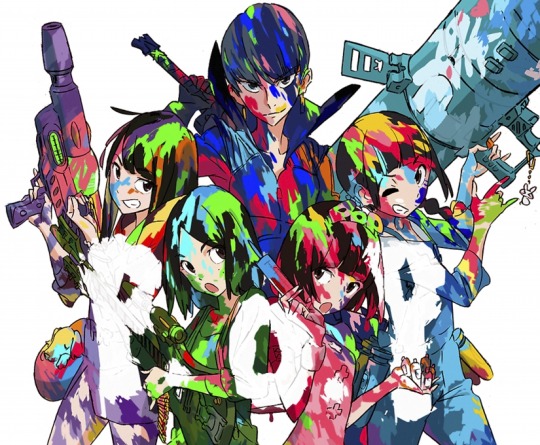
#idol#idol is not dead#idol music#japanese idol#japanese pop#japanese pop music#anti-idol#j-pop#jpop#j pop#punk#punk rock#punkrock#music blog#blog#pop#P.O.P#period of plastic 2 mercy#pla2me#plastic 2 mercy
0 notes
Text
Maison Book Girl - bath room - Review
And here we are again with another post-BiS group’s long-awaited debut album...
Maison Book Girl brings something exceptionally fresh to their fans that followed Megumi Koshoji over from the BiS-breakup. Though it’s not the first time this sound has been heard, it is the first time it’s been heard in this style and on a larger scale.
Kenta Sakurai, the producer of Mari Mizuta’s old solo project Izukoneko returns to produce Maison Book Girl’s debut album bath room with his iconic production quality that is irrefutably his; it sounds airy, free, nostalgic, and fresh. Whether it’s all general-MIDI or Nintendo 64-era soundfont libraries that make up the instrumentals of his music, I’m not too sure, but it’s breathtaking regardless.
Maison Book Girl (abbreviated as ブクガー or bukuga for hashtags and the like) was originally made up of ex-BiS member (and my oshimen at the time of BiS’ tenure) Koshoji Megumi, Miss iD 2014 finalist Kaori Soumoto, Miss iD 2015 finalist Aoi Yagawa (Miss iD is an idol contest held annually in Japan), as well as newcomers Yui Inoue and Rin Wada. Kaori Soumoto left the group in March, just a few days before the release of the group’s debut singles.
Maison Book Girl released their debut double-single Black and White back in March, and it’s been my go-to music since then. bath room features the four songs from that release as well as four new songs and an extended intro-remix of the album’s name-sake, totaling to a full 9-track album.
The album opens with an extended intro to the titular song, bath room, which almost sounds like an unfinished remix, before it kicks into the familiar kick drum and clap that was heard back in March on the White single.
Of the four new songs, snow irony is by far the strongest, with a chorus that uses repetition techniques in the word-play and melody. The song, at 4 minutes and 15 seconds draws itself out just long enough to feel satisfying, without going on for too long.
Following snow irony is the album’s strongest track, film noir which was featured as the first track on Black. film noir opens with a lively acoustic guitar progression set on delay, ping-ponging back and forth between the left and right channels in the mix. The song then continues up until the pre-chorus with this progression before kicking into a triumphant, sing-songy chorus sung by the whole unit in unison, and it works brilliantly.
Another song worth noting here without spoiling the whole album is the third track, my cut. my cut begins with a fluttering solo melody (played by what sounds like a general-MIDI wooden xylophone) and a rising cymbal crash which queues the rest of the music in at a steady, progressive pace, accented at points by a dynamic where the music cuts out and jumps right back in a beat later. my cut has a strong and emotional chorus, which is [roughly, as no official lyrics with proper kanji exist] about losing your identity: “Is your name slowly disappearing or was that really just a dream? When you lost it, I saw two blue flowers appear in the distance.” The story concludes in the final chorus with: “Why was it lost for fifteen years? Will you try to recall it? From those dry waves, my own name became two.”
The final song, water has a lo-fi quality to it, with a sample of flowing water playing underneath poetry, read by the singers, on top of a light piano solo. At the end of the song, the sound of flowing water abruptly cuts off soon after the piano and poetry, finishing up the album.
Like most of Kenta Sakurai’s songs, the instrumentals for almost every song on bath room are of a hybrid-acoustic/general-MIDI sounding nature, filled with sparkly and clever chord progressions, accidental notes that fit perfectly into the melodies, and emotionally stimulating lyrics. When I first put on White back in March, I couldn’t help but get a nostalgic vibe akin to the soundtracks of old Harvest Moon video games.
On top of having Kenta Sakurai produce their music, Maison Book Girl and Sakurai also run a fashion line which they market as their merchandise. Originally based on the group’s minimalist black-and-white designs, the fashion line has since become more elaborate with the release of bath room.
bath room has been my most hyped album in idol music this year, and it did not disappoint.
With its unique sound unlike anything you’ve ever heard (unless you were one of the rare Izukoneko fans, of course), bath room is a must-listen for any fans of BiS, Izukoneko, or new and unique idol units.
We give bath room by Maison Book Girl a perfect 10/10.
Maison Book Girl iS NOT DEAD.

#IDOL#IDOL iS NOT DEAD#Idol Music#Japanese Idol#Japanese Pop#Japanese Pop Music#Anti-Idol#J-Pop#J Pop#JPop#Punk#Punk Rock#PunkRock#Music Blog#Music
3 notes
·
View notes